Fascinating Fungi
The magical world of mushrooms

Let's Do
Supper
Luscious seasonal dishes
WILD
OCTOBER
Nature’s spectacular deer rut
BLOOMING LATE
Plants for a burst of autumn colour




The magical world of mushrooms

Let's Do
Supper
Luscious seasonal dishes
WILD
OCTOBER
Nature’s spectacular deer rut
Plants for a burst of autumn colour



Autumn 2023
9 LIFESTYLE
Inspiring ideas for your home and garden.
18 WILD OCTOBER
The annual deer rut is one of wildlife’s most exciting spectacles.
20
Brian Pike investigates some striking species you might spot this autumn.
26
Pressed flowers are a simple way to preserve a moment in time.


32 LET’S GROW
Enjoy bumper crops of fruit for years to come.

Garden news, products and advice for the new season ahead.
42 BLOOMING LATE
What to plant now for a burst of autumn colour.
49
Food news, events and fabulous seasonal, local produce.

52
Make the most of a bumper harvest by turning it into jam.
58
Claudia Blake visits The Wensleydale Heifer, West Witton.
We talk to Hannah Green, an illustrator based in Yorkshire.
68
The future’s looking bright for the much-loved Masham-based Black Sheep, says Brian Pike.

74 LET’S DO SUPPER
Emily Scott shares some luscious seasonal dishes.
82 FIRESIDE FEAST
When the weather turns cold, what could be better than sitting by the fire enjoying home-cooked food?
90 GOOD COMFORT
These mouth-watering dishes are remarkably quick and easy to prepare.

99 GORGEOUS GETAWAYS
Sri Lanka is brimming with rich history, diverse culture and spectacular wildlife.

102 COLLECTED WORKS
Collecting Toby Jugs is still a very British speciality, Brian Pike reports.
108 DALES DIARY
A guide to local events compiled by Liz Hanson.
129 TO DINE FOR
Great places to eat and stay in the Dales.
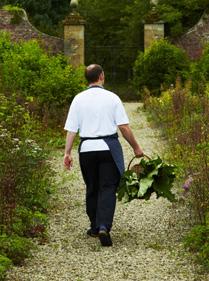
COVER IMAGE Fly agaric in woodland

EDITOR Sue Gillman
DEPUTY EDITOR Brian Pike
PRODUCTION Claudia Blake
ADVERTISING Sue Gillman
ART EDITOR Stefan Suchomski
PROOF READER Steph Morgan
PROPRIETOR Sue Gillman
CONTRIBUTORS Adam Appleyard, Claudia Blake, Liz Hanson, Lucy Hunter, Lizzie Kamenetzky, Gloria Nicol, Brian Pike, Ryland Peters & Small, Emily Scott.
Dales Life m. 07970 739119
e. sue@daleslife.com www.daleslife.com
Opinions or statements expressed in this magazine are those of the individual and not necessarily those of Dales Life.
Wherever your day takes you, make sure you stand out in a bespoke suit, or separates from Norton and Townsend.

From our showrooms in Ilkley & London we aim to cover as much as the UK as possible. Instore appointments or home/office visits to suit you.
Bespoke Suits for Business, Pleasure, Weddings, Shooting & Racing
ILKLEY
114 Bolling Road, Ilkley West Yorkshire LS29 8PN Tel: 0345 066 2030
Email: bespoke@nortonandtownsend.co.uk www.nortonandtownsend.co.uk




We’re keen for everyone to enjoy Dales Life, and you have probably noticed that we have hugely increased the number of locations from which you can collect a copy. There’s a list of them on page 122.
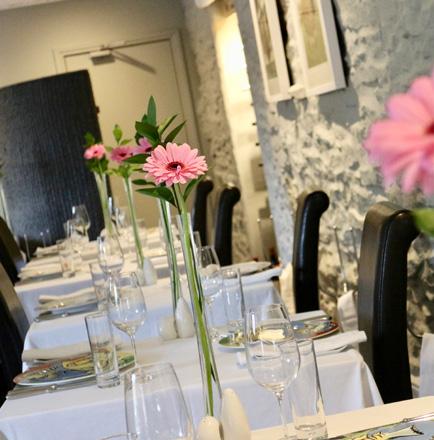

In tandem with this we have reduced the number of areas in which we deliver the magazine door-to-door. Understandably, one or two readers have got in touch to ask why.
The sad fact is that delivering door-to-door involves a significant amount of wastage. In some areas a fair number of magazines will go through letterboxes of properties that are holiday homes, second homes or are currently unoccupied – or indeed to homes whose occupants are too preoccupied to read it.

The great thing about having people pick up a copy from their local distribution point is that there is absolutely no wastage. Everyone who takes a copy does so because they genuinely value Dales Life and want to read it.
This is excellent news for the local businesses who advertise with us, because it significantly increases the number of people who see their advertisements. And it’s also great news for the environment, because we don’t want to be wasting resources printing and distributing copies that never get read.
So although it may be convenient to have a copy pop through your letterbox – as many of our readers still do – I’m sure you’ll agree that we need to do our bit for our advertisers, and for the planet, by trying to keep wastage to a minimum.


inspiring ideas for your home and garden




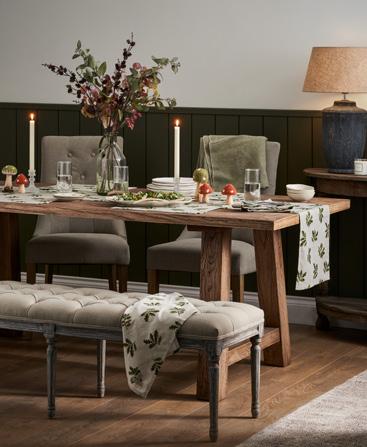

We only do 12 weddings a year. Some do that many in a week. Make one of those yours. We think your day is special. So, that’s how we treat it.

Wedding Breakfasts for up to 50 and up to 20 additional for drinks afterwards. Georgian farmhouse accommodation for 22 staying.


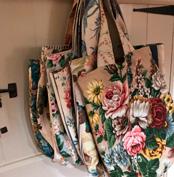
For more details please enquire: Nikki.Gray@Tel t.co.uk www.tel t.co.uk


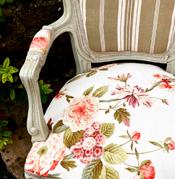

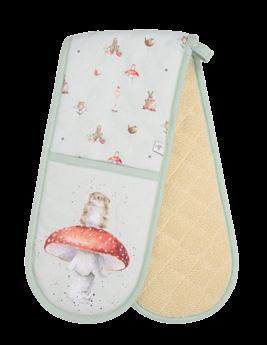




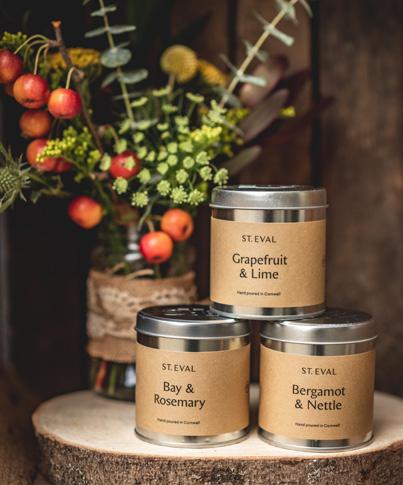
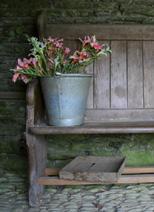







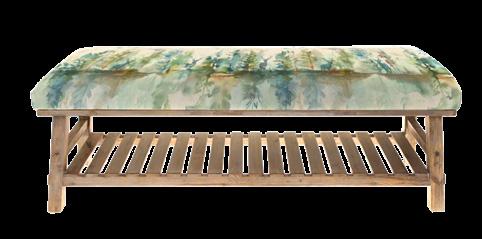


We offer home consultations to help you make the right choices to breathe new life into your home. Whether you are planning a full renovation or some small changes we would be delighted to hear from you. From a simple cushion to handmade curtains, blinds, soft furnishings and upholstery we provide a complete interior design service.

New studio opening soon in Northallerton. See our web site for further details.
emmabrowninteriors.com

M: 07801 145566
E: emma@emmabrowninteriors.com



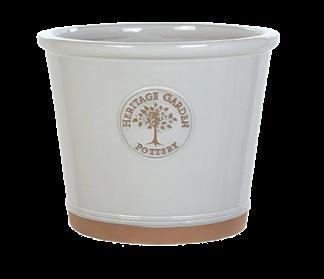

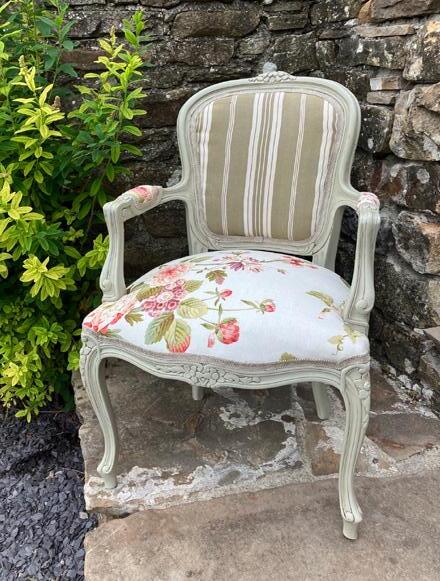
❖ VISIT Come and see us for works by the finest local and regional artists and makers.



❖ STAY We have fabulous accommodation overlooking Aysgarth Falls.

❖ CREATE We have a range of exciting art classes.


❖ GAZE We are a dark-sky friendly business involved in astronomical events.



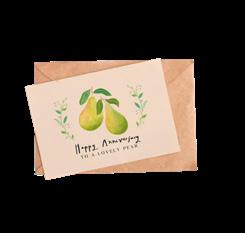
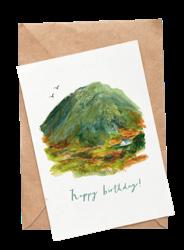






The annual deer rut is one of wildlife’s most exciting spectacles and usually takes place in October. Swinton Estate in Masham is home to over 325 fallow deer that roam freely within the confines of the Deer Park. During the rutting season the bucks can often be seen around Home Lake. You can explore the parkland and gardens upon entry with a parklands pass. For more information on Swinton Estate please visit swintonestate.com

Brian Pike investigates some of the striking species you might spot on autumn strolls



ome are tasty, some are deadly, and many of them are eerily beautiful. Fungi can pop into view at any time of year, but it’s on warm, damp autumn days that you’re likely to see the widest variety of different kinds.
Many fungi only draw attention to themselves for a day or two, spending the rest of the year hidden from sight as a dense network of microscopic threads called ‘hyphae’. These meander through soil, dead wood and other organic material, breaking it down and absorbing nutrients.
The mushrooms and toadstools that we see are temporary structures with one purpose: to distribute the millions of minute spores that will help the hidden fungi that produce them find new places to live.
There are thousands of species of fungi in the UK, many very difficult to tell apart. Let’s look at a handful of the more easily recognisable ones that you might come across in and around the Dales – some edible and some very definitely not. Remember: fungi can be deadly, so never eat any that haven’t been inspected and given the thumbs-up by an expert.
Amanita muscaria
With its white-dotted scarlet cap, the fly agaric is every child’s idea of what a toadstool should look like.
But the cheerful livery hides a darker side. The fly agaric is toxic, and potentially fatal if ingested in large quantities. In fact its name is said to derive from the fact that it was formerly used – steeped in milk – to attract and kill flies.
The fly agaric can be found in woodland from late summer to early winter, often associated with pine, spruce and birch trees.
A giant puffball in its prime is a majestic sight: a plump, pillowy white blob that can reach well over half a metre in diameter. Whilst puffballs occasionally occur in light woodland they are usually found in meadows, pasture and open grassland.
When young, a puffball’s firm, white flesh can be sliced, fried and eaten. As it ages, the inside of the puffball darkens and separates into literally millions of tiny spores. Eventually the outer skin cracks and these puff out to be dispersed by autumn winds. Avoid handling mature puffballs; in large quantities the spores can cause an allergic reaction in the lungs.
The shaggy inkcap – also known as lawyer’s wig – is common in lawns, roadside verges and woodland glades.
Like the giant puffball, it’s edible when young. It starts life as a tall, fluffy-looking, elongated egg-shape. This shoots upwards on an increasingly long stalk, opening into a narrow parasol as it goes. This soon turns black at the edges and begins to liquefy, by which point it has ceased to be edible.
Even when picked young, at the ‘elongated egg’ stage, the shaggy inkcap doesn’t keep well, so inkcaps should be fried within an hour or two of gathering them.
A treat for the eyes rather than the taste buds, the scarlet elf cup is a small, rubbery bowlshaped fungus whose shiny interior is an eyecatching fire-engine red.
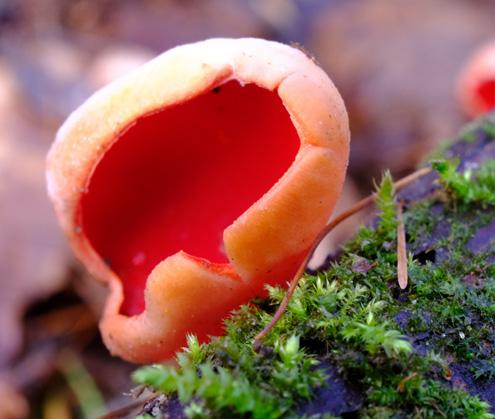
OPPOSITE Scarlet elf cup
TOP LEFT Shaggy inkcap

TOP RIGHT Porcelain fungus

BOTTOM LEFT Turkey tail

BOTTOM RIGHT Giant puffball
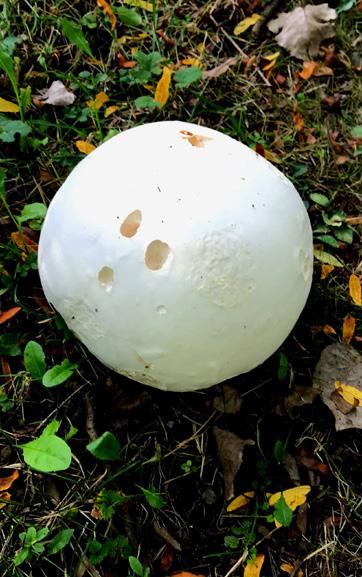
It likes damp woodland, where it grows on mossy, decaying sticks and branches in deciduous woodland, often near streams or ditches.
The scarlet elf cup tends to appear following sudden drops in temperature, from late autumn through to the following spring.
Trametes versicolor
The turkey tail is a bracket fungus, that’s to say it grows as a series of horizontal ‘shelves’ on dead wood, mainly oak and beech. Unlike the other fungi discussed so far it’s tough and durable, which means you can find it all through the year – although the colours are brightest in autumn, when it is newly emerged.
The concentric bands of colour can be very variable, including shades of reddish-brown, beige, blue-grey or black, but the outer rim is always white or cream.
Oudemansiella mucida
Few fungi can match the delicate, otherworldly beauty of the porcelain fungus, with its elegantly domed cap and glossy, translucent flesh.
The porcelain fungus grows on dead wood and fallen branches, mainly on beech but very occasionally on oak. It occurs most frequently in southern England, but can be found throughout the UK from late summer to late autumn.
Pleurotus ostreatus
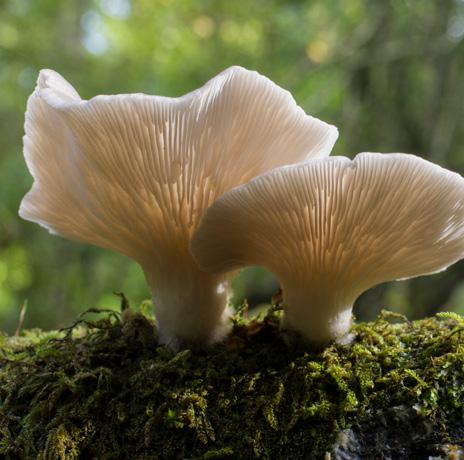
The oyster mushroom is common on dead or dying broadleaf trees. It can be seen at any time of year, but is commonest in late autumn and early winter.
It may look innocent but the oyster mushroom is a vicious carnivore, although you have to be very small to be in any danger. The fungus uses a special toxin to paralyse any nematodes – tiny wormlike creatures common in the soil and elsewhere – that touch its hyphae. It does this to supplement its diet with nitrogen, an element in short supply in rotting wood.
Laetiporus sulphureus
This striking bracket fungus – sometimes called the sulphur polypore because of its distinctive yellow-orange colour and porous underside – grows in large clusters on the dead or dying timber of oak, beech, cherry, willow and yew.
Chicken of the woods is edible but some people have an allergic reaction to it, so it should be treated with caution. Specimens growing on yew should definitely not be eaten, as they will likely have absorbed toxins from the tree they are growing on.




Pressed flowers are a simple way to preserve a moment in time, plus they also make a wonderful gift

eople have been pressing flowers for hundreds of years In a book, maybe, as a little reminder of a perfect afternoon spent in the sunshine.
The activity dates all the way back to 16th-century Japan, but became hugely popular during the Victorian era, thanks to a growing interest in natural history and the sentimental language of flowers. The technique hasn’t changed much since then, whether you choose to press your flowers between the pages of a book or magazine or use a wooden flower press. I sandwich flowers between sheets of thick cartridge or blotting paper, then slip them into piles of magazines with something heavy on top, though it can be difficult sometimes to remember where exactly I’ve put them…
Not all flowers take kindly to pressing. Bulkier plants are tricky to press well, as they hold more moisture and can go mouldy. If you want to press roses, for example, you may get better results by pressing individual petals rather than the whole flower head. Smaller flowers work better – forget-menots are straightforward to press, as are violas.
Pick your flowers on a dry day and press them as soon as possible after picking. If you’ve been keeping them fresh in a jar, make sure you dry the ends well.
* COTTON RAG PAPER OR CARD Cut this into lengths measuring 20 x 5cm for bookmarks.
* PRESSED FLOWERS OF YOUR CHOICE Here I am using Viola ‘Tiger Eyes’ and Viola tricolor (heart’s ease).
* A SCALPEL OR SHARP PAIR OF SCISSORS
* A SINGLE HOLE PUNCH
* HAND-DYED SILK RIBBON
* ACID-FREE GLUE
* FINE PAINTBRUSH
* A PAIR OF TWEEZERS
Place a large sheet of blotting paper on a flat surface and arrange your flowers carefully so that they don’t touch each other. I usually position them face down, as I find it easier to keep the delicate petals flat.
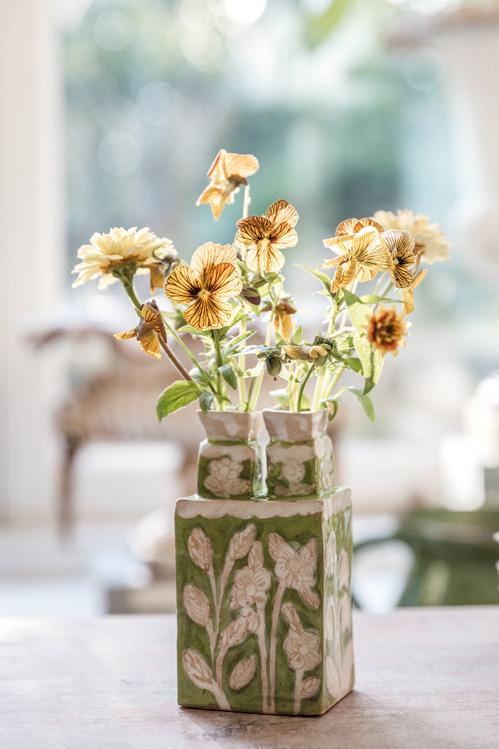
Now carefully place another piece of blotting paper over the top so that the flowers are sandwiched between two layers of paper. If you’re using a press, place the sandwich between two pieces of cardboard, close it and tighten the screws. Or close your book/magazine and place lots of other books or a doorstop or similar on top to weight it down. If you have more flowers to press, you can continue and repeat the process in a different page in the book/magazine or in the press.
Wait at least a fortnight before opening your press/book/magazine to have a peek. If your flower stems were on the thick side, you may need to leave them even longer than this to fully dry out.
Once they are dry, use a pair of tweezers to very carefully lift the flower from the blotting paper. After you’ve admired the results, store the pressed flowers on a layer of acid-free tissue paper in a dry drawer or box, or lay them out on a table so that you can see exactly what you have.
Use a single hole punch to punch a hole at the top of the bookmark in the very centre about 2.5cm away from the edge.

I like to use my pressed flowers to make bookmarks to give as gifts. I asked a local printer to blind-emboss a short quote into the bookmarks shown on these pages. Alternatively, I write the name of the flower and date it was pressed onto the bookmark in pencil.

Choose your flower. I’m starting with a ‘Tiger Eyes’ viola that I’d been admiring in a pot outside for a couple of days before cutting and pressing.
Take a 20cm piece of silk ribbon and fold it in two. Push the folded end through the hole to make a loop. Pull the two loose ends of the ribbon through the loop so that they hang free.
Pick up a small amount of acid-free glue on a fine paintbrush and carefully dot a tiny amount onto the back of the flower stem and the petals.
Using the tweezers, carefully pick up and place the flower on the bookmark, glue side down. Very gently press it into place. Now leave the bookmark somewhere flat and warm to dry. Repeat until you have used all your flowers or have the desired number of bookmarks.
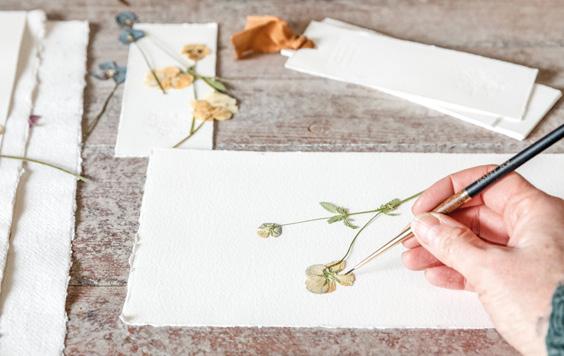
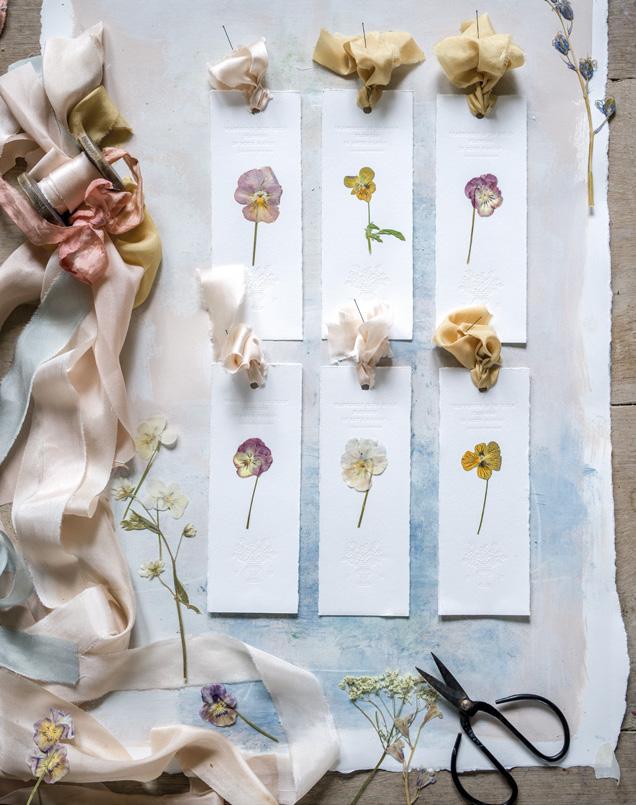
Taken from The Flower Hunter: Creating a Floral Love Story Inspired by the Landscape by Lucy Hunter (Ryland Peters & Small, £35). Photography by Lucy Hunter © Ryland Peters & Small.


Late Autumn is the perfect and traditional time for planting trees and hedging. Our range is available from late November.

If you’re missing the sunshine, look forward to next spring - our huge range of spring flowering bulbs is available from early September.

Our florist provides a full range of seasonal bouquets and arrangements including Autumn door wreaths.



01677 422861
Visit
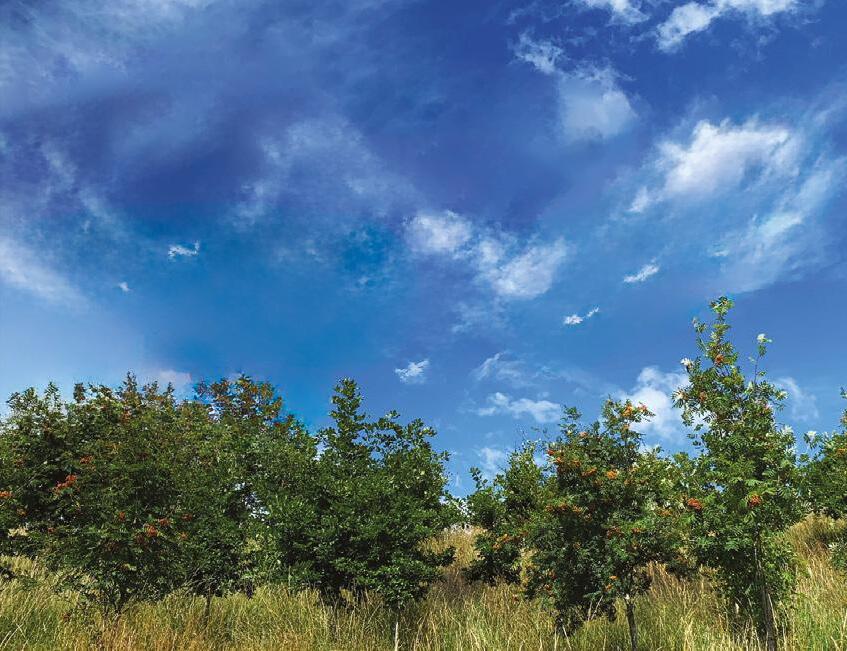



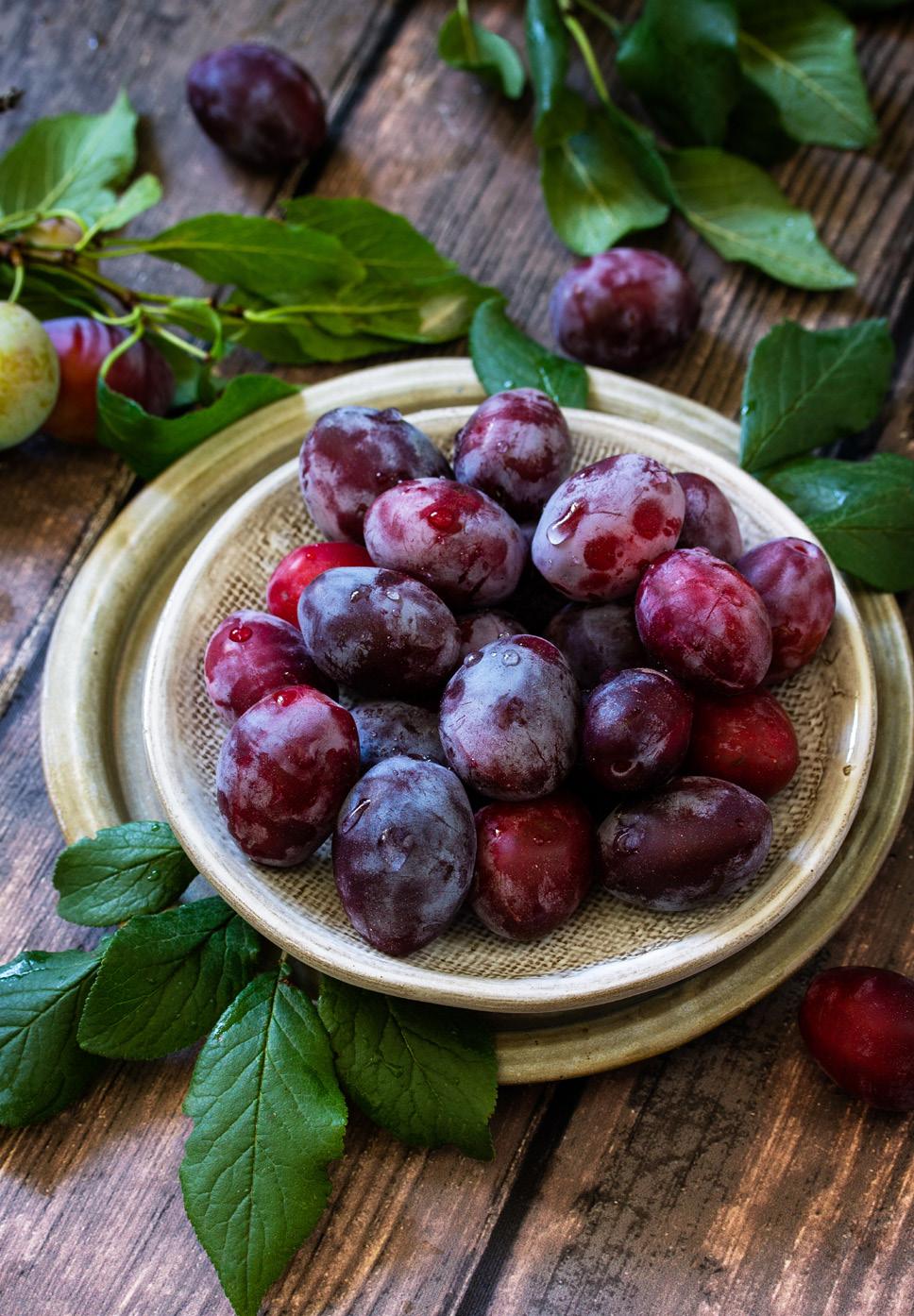
Get busy this autumn and you’ll enjoy bumper crops of fruit in years to come, says Adam Appleyard


he best gardeners always think ahead. If you want to be harvesting your own fresh fruit in the future, now is the time to make plans.
Plum, peach, apple and pear trees, along with raspberry canes, are all best bought and planted as bare-root plants. This can be done at any time between November and March, but in my opinion sooner is better than later.
Why? Well for starters, if you’re planting directly into the ground you’ll need to prepare a suitable site beforehand. Once winter takes hold the soil may well be waterlogged – or frozen hard – for days or weeks on end. Best do the hard work while the weather is still relatively mild.
Another reason to get the job done in late autumn rather than winter or early spring – even if you plan to plant into containers – is that you’ll have a better choice of plants. Nurseries hate to be left with unsold stock, so they’re understandably cautious about how many plants to propagate or order in. If you want a particular variety of fruit tree or raspberry cane you’re liable to be disappointed if you start shopping too late.
With that in mind, let’s look at each of these five fruits in turn.
Plums are best grown in a sunny, sheltered spot –somewhere that late frosts won’t blast the blooms and write off the year’s crop.
The most widely grown variety of plum is ‘Victoria’. It’s self-fertile, hence doesn’t need another plum tree in the neighbourhood in order to set fruit. The fruit themselves are good as either ‘cookers’ or ‘eaters’.
Whichever cultivar you choose, if your garden is small or you intend growing your plum in a container, choose one that’s grafted onto a dwarfing rootstock. If you’re happy to accommodate a 3- or 4-metre-high tree, choose one with a rootstock like ‘St Julien’ or ‘VVA-1’.
Another plum to consider is ‘Opal’, which was bred in Sweden and can shrug off Yorkshire winters. It’s a full-flavoured, dessert plum that crops a fortnight earlier than ‘Victoria’. ‘Opal’ is only partly self-fertile, so to maximise your harvest you’ll need another April-flowering plum nearby, either in your garden or a neighbour’s.
Peaches and nectarines grow surprisingly well in the UK, and there are several dwarf varieties suitable for growing in containers.

That said, here in Yorkshire a certain amount of shelter is a must. We grow our dwarf peach just inside our unheated greenhouse, where it benefits from air circulation on sunny days when the door stands open.
Peaches are self-fertile, but the pollen still needs to be transferred from one bloom to another. In March or April we hand-pollinate the flowers with a small paintbrush, dabbing the centre of each in turn. You can’t bank on bees doing the job this early in the year.
Good cultivars for growing in containers, often sold as ‘patio peaches’, include ‘Avalon Pride’, ‘Bonanza’, ‘Crimson Bonfire’, ‘Garden Lady’ and ‘Peregrine’. Grow them in 50cm-plus diameter containers filled with rich, moisture-retentive compost. Water regularly, especially during warm weather.
Apples are super-easy to grow, but to maximise your crop your tree needs to be pollinated with pollen from a tree that’s a different cultivar to yours. And of course for this to happen the two trees have to flower at the same time.
This isn’t a problem if you live in a town or a village. Bees range widely in apple blossom season, and several of your neighbours will undoubtedly have suitable ‘matches’ in their gardens. If you live somewhere isolated, though, it would be wise to plant two different types of apple tree that flower simultaneously.

…planting can be done at any time between November and March.
The RHS (rhs.org.uk) has a handy downloadable list of apple pollination groups to help you decide on a suitable combination.
For a free-standing or wall-trained apple tree, ‘Egremont Russet’, ‘Lord Lambourne’ and ‘Charles Ross’ – all excellent dessert apples – are good choices. For growing in a container, consider buying ‘Discovery’, ‘Falstaff’ or ‘Fiesta’ grafted onto a dwarfing rootstock.
By and large pears don’t do brilliantly in containers. They will fare better planted in a sunny, sheltered patch of fertile ground, either as free-standing trees or trained along a wall or fence.
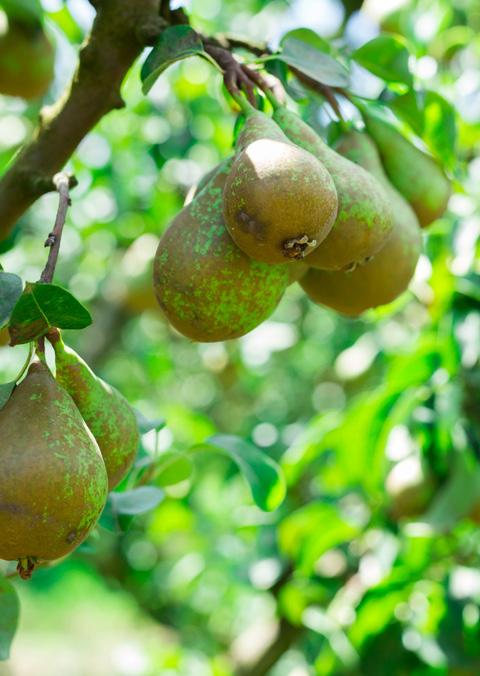
Pears are less tolerant of harsh weather than apples, so here in Yorkshire it’s important to choose cultivars that can cope with chilly winters and short summers.
Two good choices for the northern grower are ‘Concorde’ and ‘Conference’. ‘Invincible’ is hardier still. All three are self-fertile, but if you live in an isolated spot they will crop better when grown with a pollination partner. ‘Concorde’ and ‘Invincible’ would be a good combination because they flower at much the same time.
When it comes to harvesting, remember that pears are best picked before they are fully ripe, then ripened indoors.
Whether you’re planting summer-fruiting or autumn-fruiting raspberries – and, of course, with enough space you can have both – the canes are best planted in autumn.
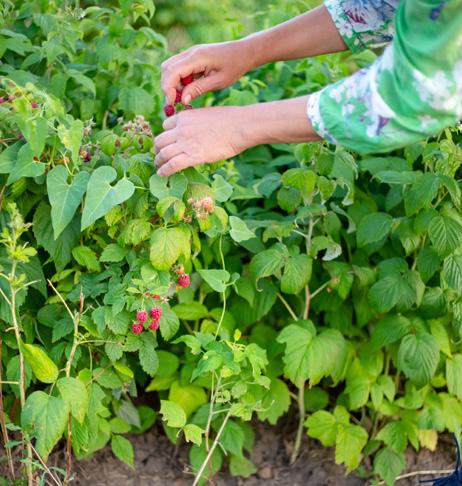
Summer-fruiting raspberries are bushy and vigorous and bear fruit in their second year, at the height of summer. Autumn-fruiting raspberries are smaller, more modest plants that will bear fruit in their first year from late summer through until autumn. Because they are more manageable, autumn-fruiting raspberries are a better choice for containers.
Raspberries like a sunny spot on rich, moist, welldrained soil, preferably on the acid side of neutral. If you’re growing them in a hard-water area, water them with rain water rather than tap water.
‘Glen Magna’ and ‘Malling Jewel’ are reliable summer-cropping raspberries. ‘Autumn Bliss’ and ‘Polka’ are good autumn-croppers.






It’s not just trees that offer spectacular autumn leaf colour. The foliage of many hydrangeas will turn a rich dusky red as the days shorten.
Hydrangea quercifolia, which bears generous heads of creamy white flowers from late summer onwards, is an especially good example. Grow it in moist, well-drained soil in sun or part shade. For a comprehensive selection of hydrangeas visit Braithwaites, Leeming Bar (braithwaitesnursery.co.uk).
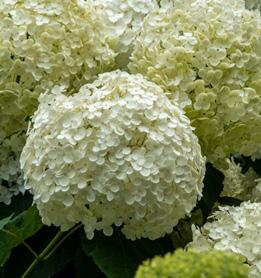
If you’re planting bulbs or weeding out dandelions, it makes sense to choose a narrow trowel – it will minimise soil disturbance and avoid damage to the roots of neighbouring plants. This slim, bronze-bladed Mira trowel from Implementations (implementations. co.uk) is one of the handsomest examples you’re likely to find!
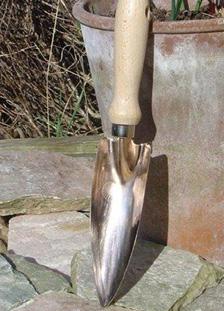
Gathering up autumn leaves can be a tiresome chore, but you’ll get the job done a lot quicker with these capacious heavy-duty leaf-grabs from harrodhorticultural.com. And remember, clever gardeners don’t burn their leaves or take them to the tip, they turn them into leaf mould; you can find instructions at rhs.org.uk
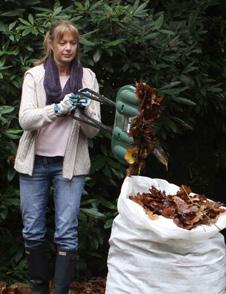
Sweet William (Dianthus barbatus) is an easy-to-grow and deservedly popular cottage garden plant that will flower next summer if sown in early autumn. Sow seed into trays of free-draining compost and overwinter in a cold frame or unheated greenhouse. Plant out infant plants early next spring and divide clumps every two years to maintain vigour.

Pumpkins and squashes must be harvested before the first hard frost. Cut the stems with a sharp knife, leaving 8–10cm of stem attached. Put the fruit somewhere warm and dry for a fortnight to harden off the rinds, then move them to a cool, well-ventilated place. Here they should last for at least three or four months.

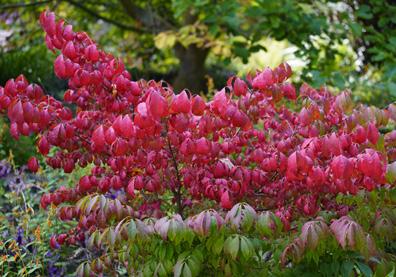
Attractive, hard-wearing and eco-friendly, hazel fencing panels are great for creating boundaries and windbreaks. They also make an excellent backdrop for the naturalistic style of planting that’s increasingly popular nowadays. You can find hazel panels at Fall Timber (falltimber.co.uk) on Leeming Bar Industrial Estate, along with a huge range of other timber garden products.

Pot feet are used to raise garden pots a centimetre or two above the ground, thereby ensuring they don’t get waterlogged or freeze during autumn and winter. Most pot feet are utilitarian little chunks of ceramic, but decorative versions are available if you want to perk up your patio – such as these charming examples from woodlodge.co.uk
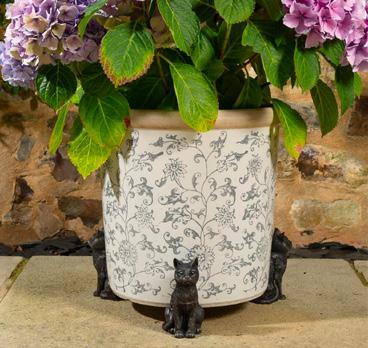
Inconspicuous for most of the year, this dense, bushy miniature shrub delivers an astonishing blast of autumn colour. As the nights grow chillier its leaves turn a dazzling shade of pinkish-red that few other garden plants can match. Grow Euonymus alatus in full sun or part shade on any well-drained soil.
There’s lots of fabulous fruit and veg to be gathered at this time of year, and a traditional wooden trug – like this one from Burgon & Ball (burgonandball.com) –is a handy way to carry it. When not being used to transport fresh produce it can double as a stylish accessory for holding indoor arrangements of fruit or flowers.
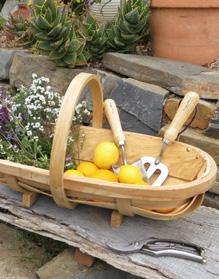
If you have a cold frame or an unheated greenhouse you can sow cauliflower seeds into trays during September and October to get an extra-early harvest next year. Transplant young plants in early spring, at which time you can sow a second set of seeds for harvesting in mid-late autumn.
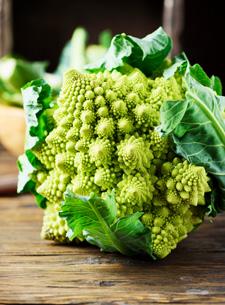






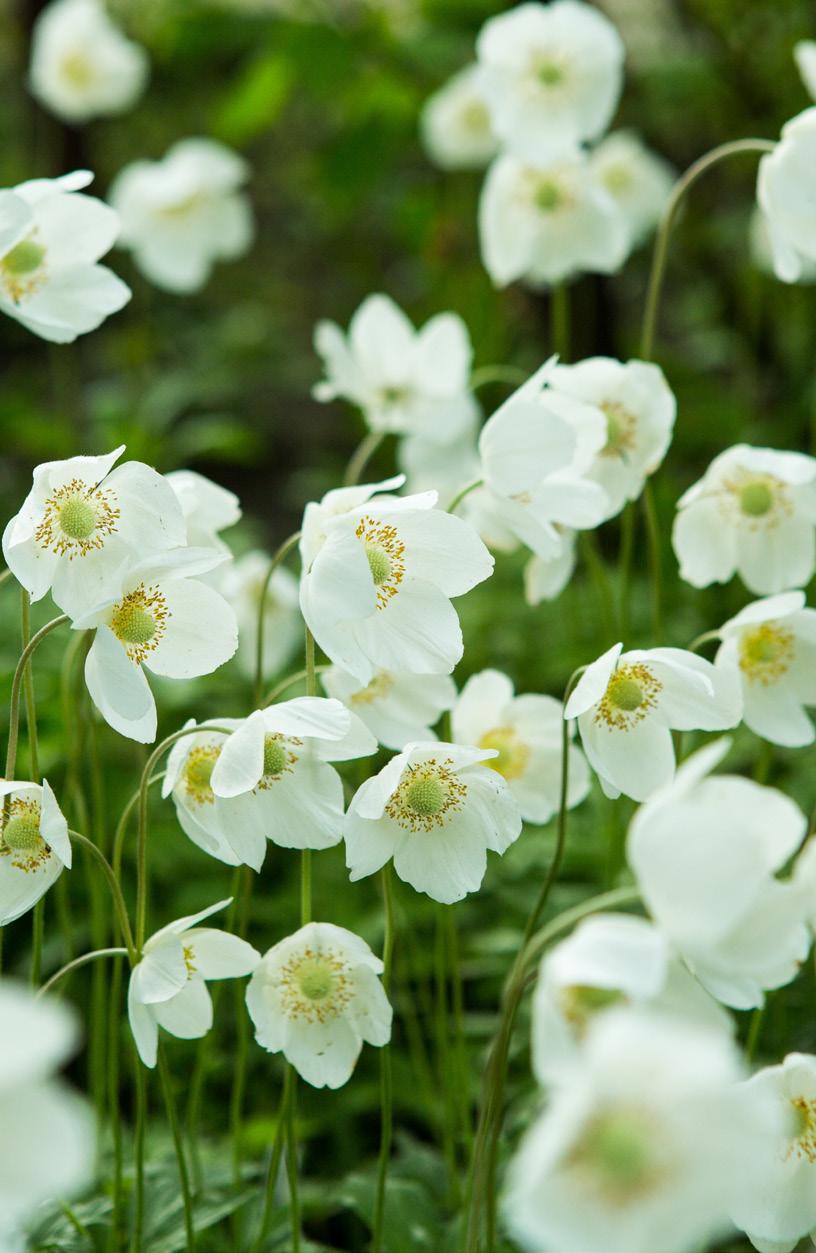
et’s be brutally honest: if your garden is a flowerfree zone in autumn, you’ve only got yourself to blame. There are plenty of colourful hardy perennials that will carry on flowering late into the year, creating a last glorious burst of colour before winter starts to bite.
The reason so many gardens look empty in autumn is that people tend to go plant-shopping in spring and early summer, well before late-flowering perennials are put out on display. And come autumn these same folk are most likely thinking of putting the garden to bed rather than adding to it.
But why not buck the trend and get some autumn inspiration by visiting your local independent nursery or garden centre right now? Here are some late-season lovelies to look out for.

Anemone × hybrida, Anemone hupehensis
Most anemones are modest little plants that flower in early spring; Anemone blanda and Anemone apennina are two of my favourites.
Japanese anemones – Anemone × hybrida and Anemone hupehensis – are very different. Tall, elegant and vigorous enough to take over large tracts of your garden if you don’t keep a stern eye on them, they produce large white or pink flowers from late summer onwards.
Like their smaller, earlier cousins they grow happily in shade, including dry shade. Ours thrive under a mature beech tree, and you don’t get much drier and shadier than that.
Anemone × hybrida ‘Honorine Jobert’ is an elegant white cultivar with an egg-yolk yellow centre; Anemone hupehensis ‘Hadspen Abundance’ has deep pinkish-purple petals. Both will prosper pretty much anywhere except waterlogged soil.
Aster × frikartii
There are plenty of pollinators on the wing in autumn, and many of them, including bumblebee queens and hover flies, will shortly be hibernating. Before they do, they need to get themselves into tip-top shape, and asters – or Michaelmas daisies as old-school gardeners call them – make an excellent end-of-year food source.
One of the best examples is Aster × frikartii ‘Mönch’, a hybrid created by Swiss plant breeder Carl Ludwig Frikart in the early 1900s. It’s a sturdy, metre-high plant with a lengthy flowering season during which it bears masses of daisy-like blooms with yellow centres and lavender-blue petals.
In general Michaelmas daisies prefer damp, slightly boggy soil, and suffer from stress-induced mildew when grown in drier spots. ‘Mönch’, fortunately, is far more adaptable, making it a good option for most Yorkshire gardeners.
Echinacea purpurea
Echinacea is another brightly coloured, daisy-like, autumn-flowering perennial. The resemblance to the Michaelmas daisy isn’t coincidental: the coneflower is the aster’s North American cousin.
Like the Michaelmas daisy, the coneflower stands a metre or so tall. It’s an adaptable, easy-to-grow plant, happy in most soils in sun or part-shade providing it doesn’t get waterlogged. It also does well in containers.
As the species name suggests, most examples of Echinacea purpurea are purplish-pink, but cultivars are available in different colourways. Two notable ones are ‘White Swan’, which has white, drooping petals, and ‘Green Twister’, which has twisted petals that are pink with lime green tips.
OPENING PAGES:
LEFT Echinacea purpurea ‘Green Twister’
RIGHT Anemone × hybrida ‘Honorine Jobert’
THIS PAGE: TOP Lily turf
OPPOSITE Aster × Frikartii ‘Mönch’
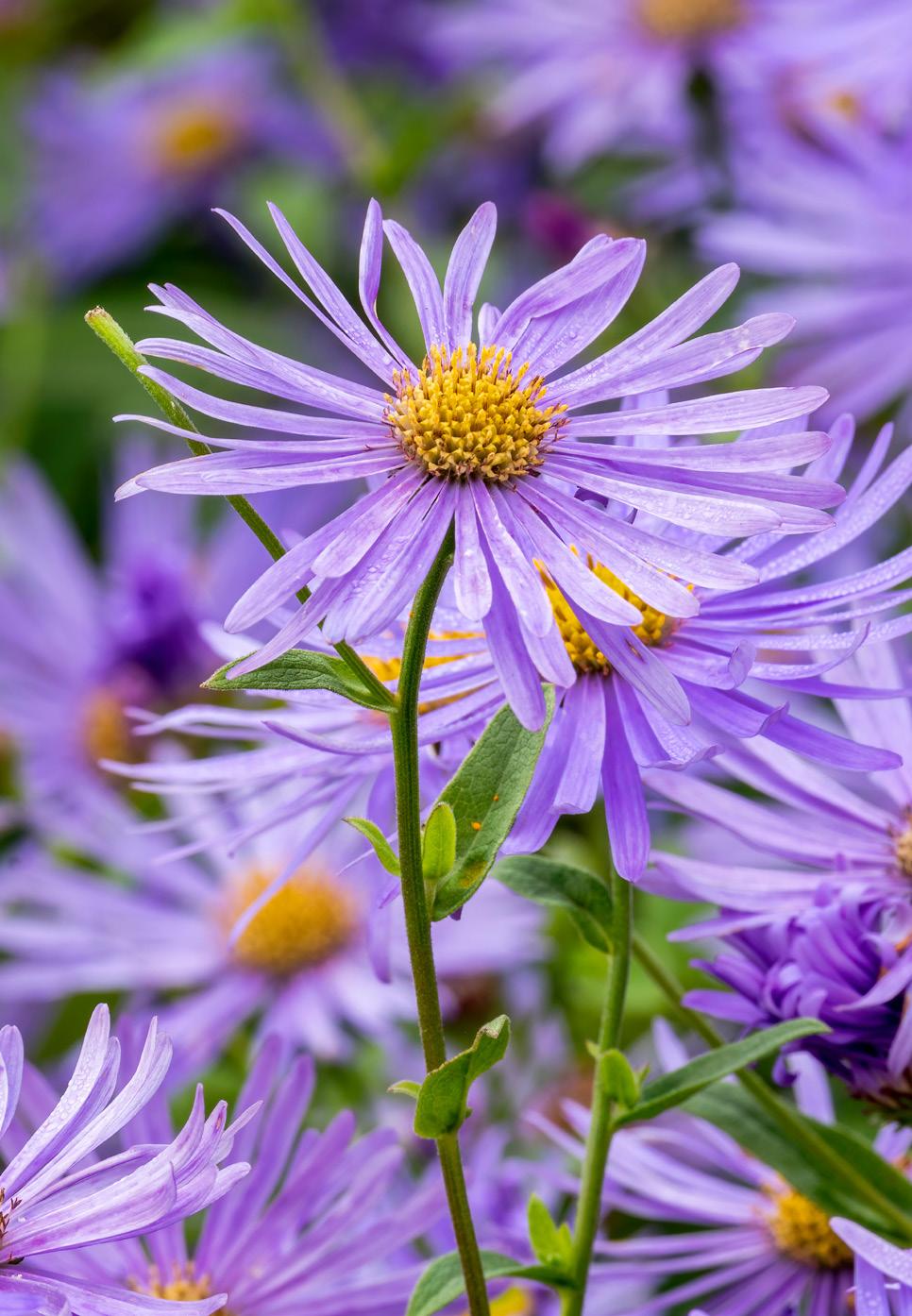
I’ve never had much success with liriope, probably because my soil is too alkaline. But if you have soil on the acid side of neutral this handsome evergreen plant makes excellent ground cover for lightly shaded areas.
Liriope’s strap-like leaves grow in neat grassy clumps 40–50cm high. From August onwards it sends up tall spikes of bluish-purple flowers reminiscent of grape hyacinths. These in turn produce blue-black berries to add interest to your borders during winter.
If purple doesn’t appeal to you, there’s a whiteflowered cultivar (‘Monroe White’), and if you want a liriope whose leaves are a bit more blingy there are stripy-leaved cultivars, although these tend to be significantly less vigorous than the plain-leaved original.
Modern genetic studies are causing scientists to revise their views about which plants should be lumped together under which names. ‘Hesperantha’ is the new name for ‘Schizostylis’, but most nurseries and gardeners haven’t yet got the memo, so let’s stick with ‘Schizostylis’ for the present.

Schizostylis is a sun-loving plant in the iris family, and hails from South Africa. It will grow to around 50cm high and produce stems of scarlet, pink or white six-petalled flowers from late summer through to late autumn. To ensure the best display, keep plants well watered during summer.
In suitable conditions schizostylis will spread enthusiastically, even popping up in gaps between paving stones and other challenging sites, so if you’re prepared to wait a single plant will eventually colonise an extensive area.
I’m at a loss to explain why so many autumn perennials have daisy-like flowers, but here’s yet another. Michaelmas daisies give us vibrant violets, echinacea give us eye-popping pinks. The Indian chrysanthemum extends the year-end colour palette still further with rich, egg-yolk yellows, tinted with red or pink in the case of certain hybrids.
Chrysanthemum indicum grows best in fertile, well-drained soil in full sun. In exposed situations it would be sensible to protect it with a layer of mulch over winter. Alternatively, keep a pot of rooted cuttings in your greenhouse as an insurance policy.

All over Yorkshire, our thousands of happy customers have improved their homes with the superb quality of our products and workmanship and are taking advantage of great energy savings, security and style. From contemporary to traditional, we can design and fit a bespoke range of top quality window and conservatory solutions in a colour and style to suit you. The power of colour. The right choice of colour can greatly enhance the look of your new windows and doors.


At Lifetime we offer a bespoke colour service to all of our products. Choose from a Farrow & Ball or Fired Earth colour chart. Or bring us a colour and we will match it. All the benefits of maintenance free uPVC windows and doors while retaining the charm and character of your home.
Talk to the experts – we can bring your ideas to life. We offer a no obligation design and quotation service, so contact us today and tell us about your plans – we’ll be delighted to hear from you.
The nest quality fruit, vegetables and salad
Wide range of dairy and ambient groceries

Quality selection of garden and house plants
Home delivery service
Trade welcome
Online shop
Monday-Friday 7.30am-5pm, Saturday 7.30am-4pm
Home of the Yorkshire Dales Meat Company

We offer a fantastic selection of artisan foods including jams and preserves, pasta, puddings, free-range eggs, cakes and pies.


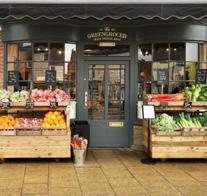
Our expert butchery counter is bursting with a vast range of delicious Aberdeen Angus beef, local lamb, pork, sausages, burgers and much more.
Locally sourced gifts include Yorkshire Candles, Richmond Soaps and a selection of colourful art.
We are proud to support local businesses throughout Yorkshire.
www.yorkshiredalesmeat.co.uk Tel: 01748 810042

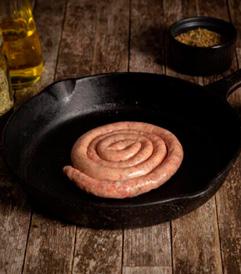
Yorkshire Dales House, North Road, Hackforth, DL8 1FN Open Tuesday to Friday 10am-3pm
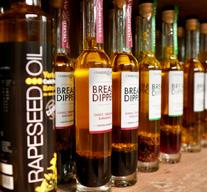


Game is plentiful in autumn, but cooking these delicious wild meats successfully requires a certain amount of know-how. Fortunately there’s a quick and enjoyable way to get up to speed with game cookery. The Swinton Estate Cookery School is running a hands-on, one-day course on 14 October that will help both novice and experienced cooks make the most of this seasonal bounty. For more information visit swintonestate.com/cookeryschool

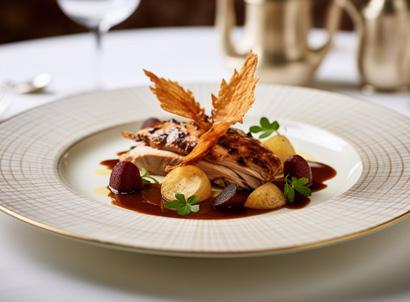
From now until early December, Yorkshire grouse, with its rich, gamey taste, is a highly anticipated culinary treat. And naturally you’ll want to buy the best and freshest birds. Game-loving gourmets can rest assured that, as per usual, the butchery department at Campbell’s of Leyburn (campbellsofleyburn.co.uk) will be stocking their counter with the very finest local grouse, sourced from specialist dealer L&A Dent of Carlton-in-Coverdale.
Regenerative farming is a holistic approach to agriculture that aims to improve soil health, enhance animal welfare and promote biodiversity. New business eatTelfit works with and supports a number of ethically-run, regenerative or sustainable small farms in Yorkshire, offering grass-fed beef and lamb and free-range pork –meat that not only tastes great but is produced in a planet-friendly fashion. Find out more and explore eatTelfit’s product range at eattelfit.co.uk
Many vegetables are at their best right now, none more so than pumpkins and squashes. And don’t forget that they’re more than just Halloween decorations – they make excellent soups, stews and side dishes, and the seeds can be roasted for a tasty and nutritious snack. For an excellent selection of pumpkins, squashes and other autumn veg visit The Greengrocer in Market Court, Bedale (thegreengrocer.co.uk).
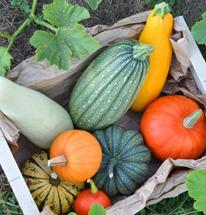
Crisp, dry and naturally effervescent, Thornborough Sparkling Brut Cider makes a terrific alternative to Champagne or Prosecco. Crafted from local apples and natural yeasts – with not an additive in sight, and no extra sugar – it’s made in small batches using painstaking traditional methods. You’re welcome to visit the cider mill (by prior arrangement) to find out how! To discover more about Thornborough Cider or to buy online, go to thornboroughcider.co.uk

If you enjoy top quality meat, the butchery counter at Mainsgill Farm Shop (mainsgillfarm.co.uk) is the place to get it. Here you’ll find traditional grass-fed beef, lamb and pork raised in the lush pastures of the Holmedale Valley. And Mainsgill’s award-winning butchery team can expertly prepare whatever cut of meat you require. Special occasion coming up? No problem; just have a word with them and they’ll make sure you get everything you need.


Fancy frying up some banging bangers? Mill Close Farm Shop (yorkshiredalesmeat.co.uk) at Hackforth has plenty to choose from. Made on site, their Yorkshire Dales sausage range includes lots of mouthwatering flavour combos, including pork, leek and cranberry, pork and ale, and pork and chilli. But it’s their autumn special that sounds particularly intriguing: believe it or not, a toffee-apple flavoured sausage! Sounds like a winner.
Wondering what to do with your windfalls? Saturday

7 October is Apple Day at Ripon Walled Garden. Bring along your apples to be juiced and bottled and you can enjoy your very own fresh apple juice at home! As always there will be stalls, music, refreshments and plenty of other fun activities for all the family. Open 10am to 4pm.

A spoonful of top-rate chutney will transform a cheeseboard or plate of cold cuts into something really special, and Raydale Preserves, based near Hawes, know a thing or two about creating cracking condiments. You can find a selection of Raydale Preserves’ wares – including their beguiling Pear Chutney with Semerwater Ale – at Booths in Ripon (booths.co.uk).

‘You are what you eat’ is as true of poultry as it is of people. That’s why the birds from Herb Fed –free-range fowl, raised on a unique diet that includes more than ten varieties of fresh herbs – taste so very delicious. You can find out more about the award-winning business, and order online, at herbfedpoultry.co.uk
































Where I live we have our own locally grown plum variety, the Blaisdon Red plum, so naturally that is my own particular favourite for this jam. Most years, come late summer, the trees are dripping with them, so there is always lots of jam making to be done. Of course, other plum varieties will do just as well.
MAKES ABOUT 750G
450g plums, halved and stoned
450g warmed sugar
1 Place the plums in a pan with 100ml water and bring to a simmer, then cook gently for 10 minutes until the plums are soft but still intact.


2 Add the warmed sugar to the fruit and stir over a low heat until all the sugar has dissolved, then turn up the heat and boil rapidly to reach setting point. Skim if necessary.
3 Pour the jam into hot, sterilised jars and seal.
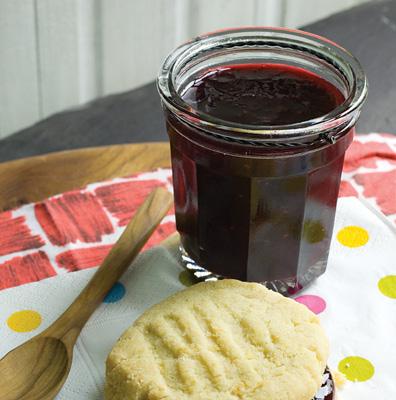
I discovered this combination when I found a bargain pack of nectarines at the supermarket. They bring a welcome sharpness to the mellow flavour of blackberries as well as an appealing texture.
MAKES ABOUT 1.5KG
900g blackberries
1 star anise
3 cloves
1 small cinnamon stick
4 nectarines (approx. 430g when skinned and stoned)
juice of 2 lemons
900g warmed sugar
1 Place the blackberries in a saucepan with the star anise, cloves, cinnamon stick and 2 tablespoons water (just enough so the fruit doesn't catch on the base of the pan). Bring them to simmering point and continue cooking until they are tender and juicy, mashing them with a spoon.
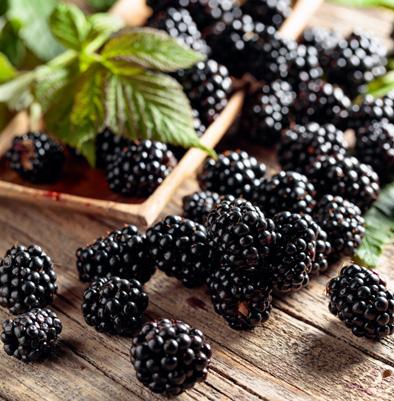
2 Remove the cinnamon stick and press the berries through the fine disc of a food mill or a sieve/strainer. If you prefer a chunkiertextured jam, there is no need to purée the fruit at all: simply remove the spices with a spoon and continue with the whole blackberry pulp.
3 To skin the nectarines, place them in a bowl and pour boiling water over them. Leave for a few minutes, then drain off the water and replace with cold water; the skins should slip easily off the fruit. Cut the nectarines into quarters, removing the stones, then cut each quarter into thirds (smaller pieces if you like a finer-textured preserve).
4 Place the blackberries, lemon juice, nectarines and sugar in a preserving pan and heat through, stirring gently, until the sugar has completely dissolved, then turn up the heat and boil the jam rapidly to reach setting point. Skim if necessary.
5 Leave the jam for 5 minutes, then stir to redistribute the nectarine pieces. Pour the jam into hot, sterilised jars and seal.
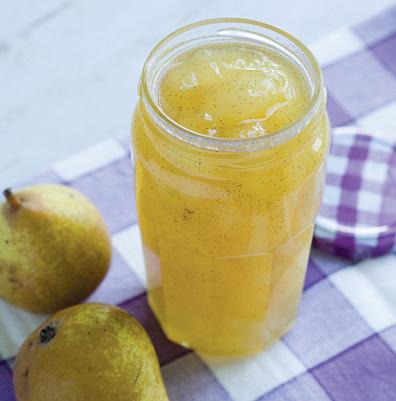
This jam is another of my particular favourites and is one I find it hard to live without. The specks of real vanilla dotted throughout the pale jam show its quality, infusing their aromatic flavour. Here, macerating the pears also brings out the most flavour from the fruit.
MAKES ABOUT 1.3KG
1kg pears, peeled, cored and cut into chunky slices
juice of 2 lemons
750g sugar
1 vanilla pod
1 Place the pears in a bowl with the lemon juice to stop them discolouring. Sprinkle the sugar over the fruit and add 200ml water.

2 Slice the vanilla pod in half lengthways and scrape out the seeds, then tuck the pod in among the pears and add the seeds. Cover the bowl with a plate and leave overnight for the sugar to soak up some of the juices from the fruit.
3 The next day, pour the contents of the bowl into a preserving pan and stir over a low heat until the sugar has dissolved, then turn up the heat and boil rapidly to reach setting point by which time the pear pieces will be translucent. Skim if necessary.
4 Remove the vanilla pod, then pour the jam into hot, sterilised jars and seal.
You can use a black cooking cherry, such as a Morello cherry, for this jam or a paler dessert cherry and the colour of your jam will vary accordingly. If you grow your own, make sure to pick them as soon as they ripen or else the birds will eat the lot before you get the chance.


MAKES ABOUT 900G
700g cherries
500g warmed sugar
1 tablespoon lemon juice
1 Stone the cherries over a basin to catch any juice. Place the stones in a piece of muslin and tie it into a bag with string. Put the fruit and juice in a pan with 2 tablespoons water and simmer gently until the fruit is just cooked.
2 Add the warmed sugar and the lemon juice to the fruit and stir over a low heat until all the sugar has dissolved, then turn up the heat and boil rapidly to reach setting point. Remove the muslin bag and leave the jam for 5–10 minutes, then stir to redistribute the cherries. Skim if necessary.
3 Pour the jam into hot, sterilised jars and seal.
Recipes taken from Preserves and Pickles by Gloria Nicol, published by Ryland Peters & Small (£16.99). Photography © Ryland Peters & Small.

Enjoy Roux Scholar Jonathan Harrison’s unique cuisine in the traditional surroundings of the Sandpiper Inn.

Modern British food using only the finest local ingredients, beautifully prepared and presented.



Fine wines, real ales and friendly service.
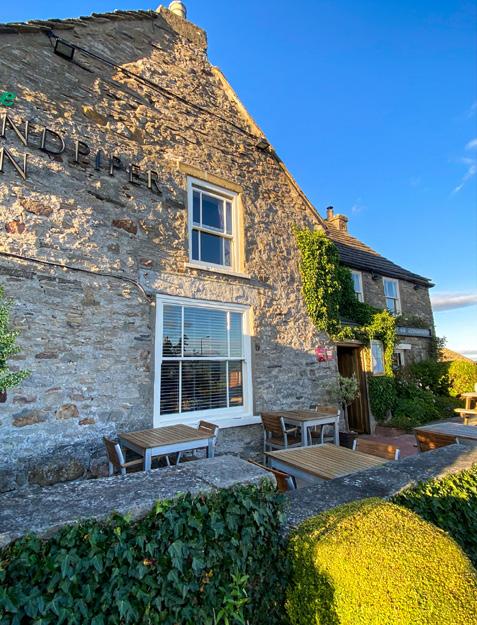
Accommodation available.
Market Place, Leyburn, North Yorkshire DL8 5AT sandpiperinn.co.uk
Tupgill Estate, situated in the heart of the Yorkshire Dales with 513 acres of glorious Yorkshire countryside, is home to e Saddle Room restaurant.
At e Saddle Room we believe passionately about sourcing our ingredients from really local suppliers and wherever possible within a 10-mile radius of the restaurant.
e Saddle Room also has 5★ rated Accommodation with Cottages and Bed and Breakfast rooms creating the perfect place to relax and unwind.

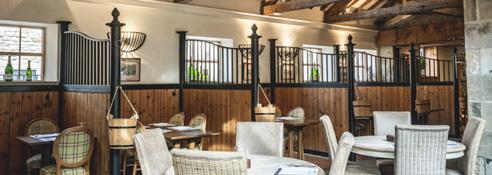

✓ OUTDOOR DINING IN “THE PADDOCK”
✓ NEWLY REFURBISHED ACCOMMODATION
✓ OPEN FOR WEDDINGS AND EVENTS

✓ PRIVATE DINING
Grand honest food cooked to perfection

Winner of Best Restaurant Herriot Awards


01969 640 596 | info@thesaddleroom.co.uk
Tupgill Park, Coverdale, Leyburn, North Yorks DL8 4TJ www.thesaddleroom.co.uk
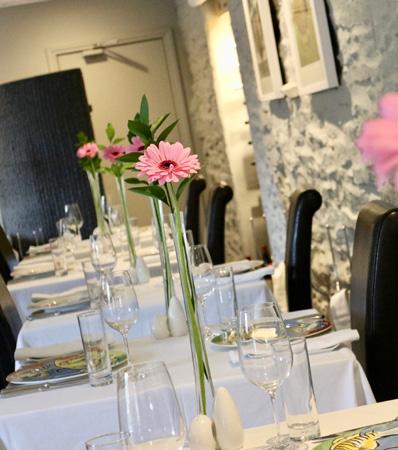
Claudia Blake visits
The Wensleydale Heifer at West Witton

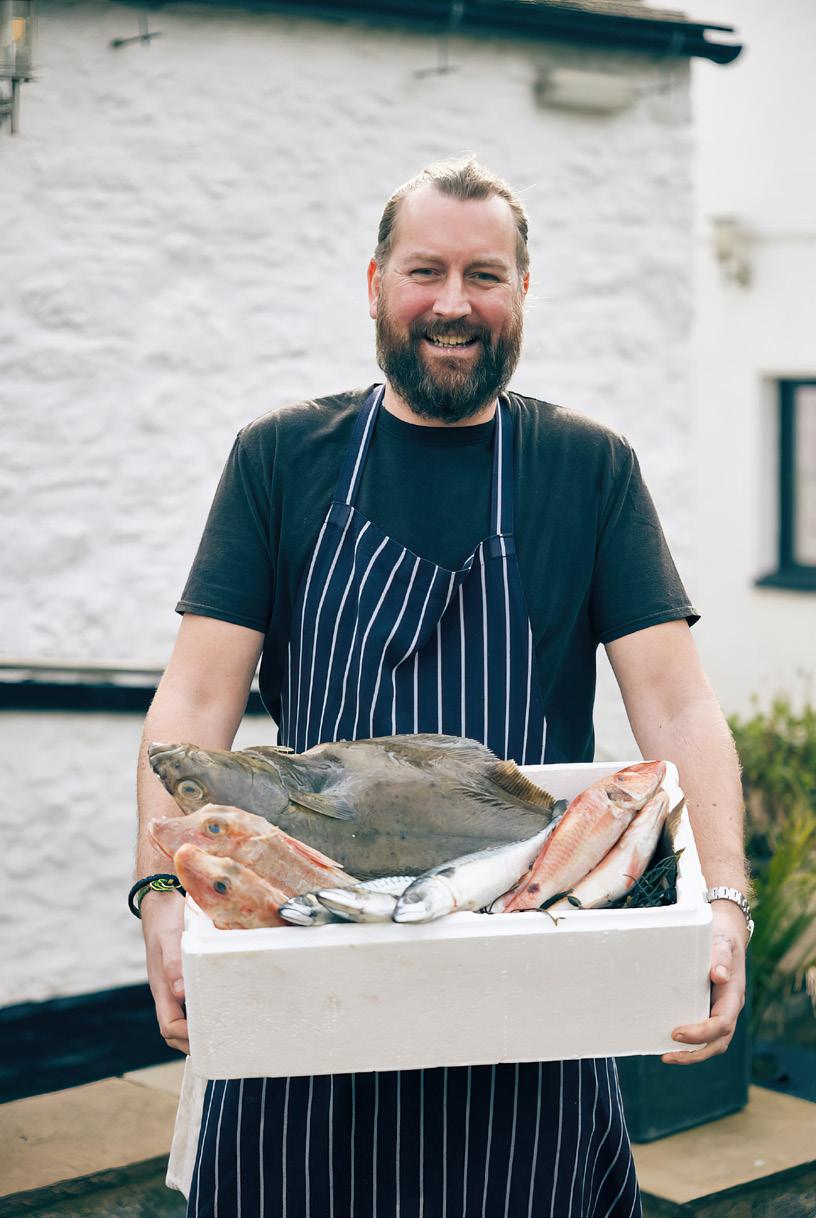
ales villages don’t get much more linear than West Witton. It stretches out along the A684, Wensleydale’s arterial road, for near on a mile. A little west of centre you’ll find The Wensleydale Heifer, perched on the edge of Mill Beck, which tumbles down towards the Ure from the lower slopes of Penhill. Peer over the rear wall of the Heifer’s car park to marvel at just how deep a chasm this sprightly stream has carved.
Neatly whitewashed and fronted by a pristine white picket fence, the Heifer consists of a loose aggregation of traditional stone-built Dales buildings. Its cheery pub sign, however, is anything but traditional. It depicts a cartoon cow fishing from a rowboat, referencing the inn’s longstanding reputation as a magnet for seafood enthusiasts.
Indoors, the theme of old and new continues. The interior has all the black-beamed charm of a traditional Yorkshire hostelry, jollied along by a selection of unashamedly colourful contemporary artwork. Not, perhaps, what you would expect from a country inn, but the combination works well enough.
The Heifer has a variety of different dining spaces, each with its own atmosphere: bar, snug, fish bar and dining room. Even midweek, all are apparently booked out. Clearly the Heifer has an enthusiastic following.
It also has an enthusiastic front-of-house team. Despite the fact that it was a busy service there were none of those annoying longueurs that can spoil the flow of an evening out. Black-uniformed staff were quick to take our orders, and the chefs backstage were prompt to fulfil them.
Our starters, which arrived hot on the heels of some pleasantly crusty home-baked bread rolls, were plated with precision and style on characterful crockery.
One was a salad of burrata – which is a fresh, soft Italian artisan cheese – along with heritage tomatoes and cured Italian ham. Enlivened by a piquant pesto, the plateful conjured up fond memories of alfresco Continental dining. The tomatoes in particular had the beguiling intensity of flavour that modern tomatoes so often lack.
Our other starter was whisky-smoked salmon with new potatoes, a soft-boiled egg and a variety of vegetable bits and bobs including beetroot and radish.
Rich and unctuous, the salmon was first rate. Like the burrata salad, this was a starter that was tasty and packed with detail, but light and bright enough not to dull our appetite for our mains.
The first of our main courses was a whole roast Whitby plaice, served on the bone with French fries, wilted spinach and a caper, lemon and parsley brown butter.
The fish was enormous and perfectly cooked, so no complaints there. But in retrospect I wondered if Chef had missed a trick by not filleting it and serving it with something with a bit of texture. Plaice is soft and moist, spinach is soft and moist, hot butter is liquid… Yes, the chips were commendably crisp, but I thought the plate needed a little je ne sais quoi to take it to the next level.
Fortunately no tricks had been missed with our other main: roast rump of Dales lamb. This was, in short, simply stellar. The luscious lamb rump was accompanied by a deeply flavoursome slow-braised piece of belly lamb, a rich jus, tenderstem broccoli and a dreamy mélange of minted pea purée and broad beans. I really could eat this sort of thing all day, every day.
And this magnificent main was followed by two equally magnificent puds. One was a perky tiramisu with brandy snaps and an espresso and salted caramel ice cream. I’ve always been a fan of tiramisu, and this one was a fine specimen.
Better still – top-notch in terms of both presentation and flavour – was a trio of lemony offerings, namely a lemon posset, a lemon Alaska and a tiny lemon crème brûlée. Three miniature marvels, all riffing on that made-inHeaven contrast between sharp citrussy notes and self-indulgent creaminess… definitely my kind of dessert!
These splendid sweets were a triumphant conclusion to a thoroughly enjoyable meal. And proof, if it were needed, that whilst the Heifer’s menus major on seafood – with oysters, lobster, prawns and scallops all featuring prominently –there are plenty of other, non-marine delights to tempt hungry gourmets through the door.
For more information about The Wensleydale Heifer visit wensleydaleheifer.co.uk or call 01969 622322.
Delicious food, beautifully presented.
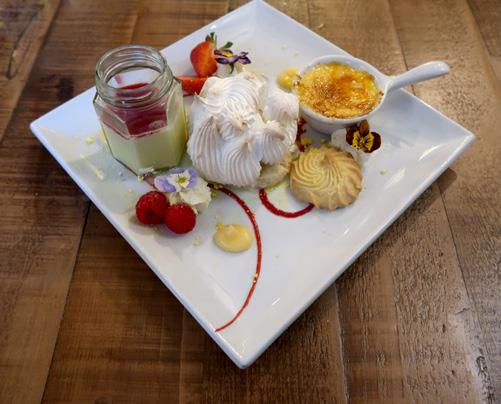

Cheery modern makeover of a cosy Dales hostelry.

Friendly, prompt and efficient.
Three courses each for two cost us just north of £100, that’s to say around £50 each, drinks not included.
Wines by the glass start at £4.70 for a 125ml glass.
The Wensleydale Heifer is also a boutique hotel with thirteen individually themed rooms and a luxury family holiday cottage.


Each lodge is fully equipped and has its own private hot tub set down into the balcony. Peaceful setting so guests can have a relaxing and enjoyable time.







Match your walls and wood trim for a contemporary twist. We stock the full Dulux range and we can match and mix more colours too.



From an early age, Hannah Green loved making art. And now she has fulfilled a longstanding ambition by turning her passion for creating images into a full-time career.
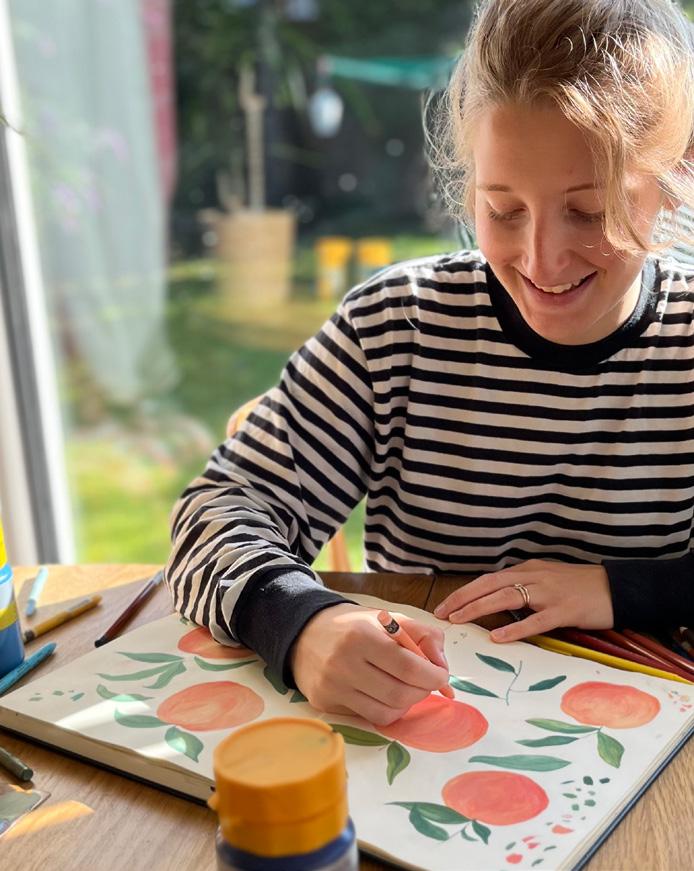
Born in York, Hannah studied art at A-level and then – encouraged by her teacher – went on to do a oneyear foundation course at Leeds College of Art.
Art foundation courses give students a chance to explore a range of different creative disciplines. Hannah discovered that she particularly enjoyed illustration, so she decided to study for an Honours degree in the subject at Cambridge School of Art.
Since 2020, when she graduated, Hannah has been back in Yorkshire, building up her business as a selfemployed illustrator.
One aspect of being an illustrator that especially appeals to Hannah, she says, is that it allows her to get involved in a huge variety of different activities.
A brief scroll through her website gives a hint of some of the projects she is currently involved in. You’ll find prints and postcards, a huge range of different greetings cards and some gorgeous gift wrap.
But that’s just the tip of the iceberg. Hannah also accepts commissions for projects as diverse as children’s book illustrations, bespoke wedding stationery and logo design. And in future she hopes to apply her design skills more widely still – to textiles, for example, or ceramics.
Hannah likes painting from life, in a style she describes as “painterly but realistic”. Her favourite subjects are natural landscapes and botanical illustration, with animals and birds not far behind. Her landscape prints range from studies of Aysgarth Falls, the Hambleton Hills and various Yorkshire towns to scenic views of Scotland and even an evocation of the awe-inspiring mountain scenery of New Zealand. The botanical studies featured on her greetings cards are equally eclectic, and include a wealth of colourful fruit, vegetables and flowers.
There’s a breezy lightness and good-humoured charm about her work, helped along – in the case of the greetings cards – by the occasional pun: “Happy Anniversary to a Lovely Pear”, for example, or “Birthday Fishes”. These are feel-good designs, clearly made by somebody who thoroughly enjoys what they are doing.

To create her images, Hannah combines a variety of techniques, old and new. “I use acrylic paints, and sometimes gouache,” she explains. “Often I will work on top of the initial painting with wax crayons or coloured pencils, and then maybe scan the piece and tweak it digitally on my iPad.”
Hannah sells her work through various shops and galleries in Yorkshire. She also sells online, direct from her website and via Etsy and notonthehighstreet.com – which of course means she now has an enthusiastic following of buyers throughout the UK and overseas.

Being a self-employed illustrator can have its downsides, she says. “People imagine you happily painting away all day, but it can be quite lonely in the studio, and sometimes it can feel very pressurised, especially when multiple deadlines are looming and you have creative block. There are days when you just can’t get ‘in the zone’.”
But there are always positives. “It’s great to have a job that lets me do something I’ve always enjoyed. I love the fact that being an illustrator is so varied and involves so many different kinds of work. And of course it’s lovely to see your creations out there, and to know that people are enjoying them.”
You can find out more about Hannah and her work at hannahlgreen.co.uk, where you’ll also find links to her Instagram and Facebook feeds.

The much-loved Masham-based brand is busy brewing up new ideas – and the future’s looking bright. Brian Pike meets Executive Director Jo Theakston.



e’ve spent thirty years improving our beers and building a great brand. Now we’re looking to the future, and we’re more determined than ever to take Black Sheep from strength to strength,” says Jo Theakston, Executive Director of the iconic Masham brewery.


“Times have been difficult for everyone in the brewing and hospitality industries. But we’re still here, and we’ve got plenty of exciting plans for the months and years to come.”
This spring there appeared to be a question mark hanging over the company’s prospects, with news that it had announced a ‘strategic review’ of its operations casting a pall of gloom over the Dales. Fortunately, however, the brewery and its popular visitor centre were purchased by investment firm Breal Capital, safeguarding jobs and ensuring that the Black Sheep name will continue to be a familiar sight in bars and on shelves in the drinks aisle.
“The pandemic, followed by increased costs in the last year and changes in the economic climate, put us under huge strain,” says Jo. “The news that we were struggling came as a shock to local people. But not only did the deal with Breal Capital preserve a muchloved and well-established business but – perhaps most importantly – it safeguards the jobs of our employees, most of whom are locally based.
“Breal aren’t here to tear everything up and start again. The quality of what we’re doing hasn’t changed, nor is it going to. And we’ll be continuing to innovate and try out new and interesting ideas. The market is shifting very quickly, and we intend to rise to that challenge.”
“One of the biggest changes in the industry over the last decade has been the decline in the consumption of cask beer – which, as far as everyone else in the world is concerned, is a hallowed and uniquely British drink.

“Currently the average age profile of cask beer drinkers is fairly high. So we’re campaigning hard to get people, and especially younger drinkers, to appreciate just how amazing and carefully crafted a product cask beer is. Our message is that we need your support, and your local pub needs your support, especially here in the Dales!
“Last year we launched Respire, our first carbonneutral cask beer. It’s a 4% session IPA with bright, citrussy notes from Citra and Chinook hops. Steel casks are inherently sustainable; each one has an average lifetime of more than 20 years.”
“The whole brewing and cask-filling process has been independently audited and officially certified as having a carbon-neutral footprint, thanks to improvements in our processes and carbon offsetting that goes to fund high-impact biodiversity projects.
“This April, having also audited our bottling process, we launched Respire in bottles in supermarkets and via our online store.”
“Craft beer is another sector of the market that has seen dramatic changes over the last few years. Not so long ago it was all about cloudy beers with big, hoppy flavours. Nowadays, whilst there’s still a huge amount of interest in those styles, I think the younger generation is increasingly aware that traditional beers are also ‘craft’ beers, and that what’s important is the quality and the attention to detail that goes into the brewing process. And of course our fermentation style – using Yorkshire squares – is a pretty unique way of making beer.”
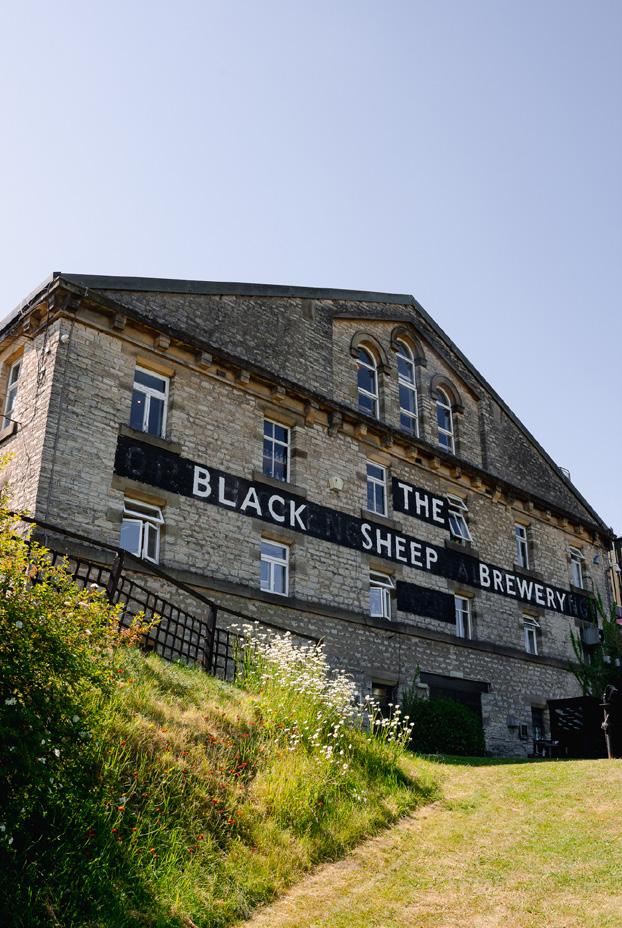
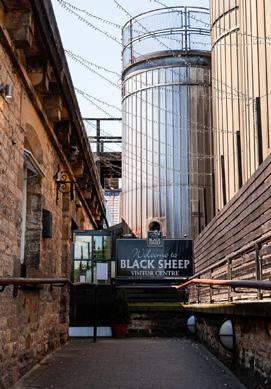



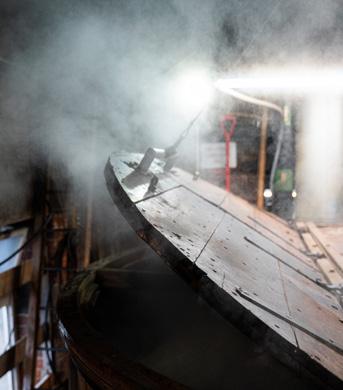
“So we’re continuing to develop our range of craft beers – more will be breaking cover over the next few months. And we’re moving towards more canned products now that we have our own inhouse packaging line.
“Another recent initiative that we’re extremely proud of is our Burrow’s Blonde, which we launched this August. It is a light, zesty beer brewed for inspirational Leeds Rhinos legend and Rugby League champion Rob Burrow MBE, who lives with Motor Neurone Disease (MND). Burrow’s Blonde is available on cask in pubs and bars and in 500ml bottles, and 10p from every pint or bottle goes to support Rob’s family and the MND community.

“Looking to the future, we’ll be continuing to push our drive towards sustainability. We’ve made a great start with Respire and there’s no reason why we can’t repeat that success with our other beers to ensure we meet Yorkshire’s target of being carbon neutral by 2034.
“Another important change in the market is the increasing popularity of no-alcohol and lowalcohol beer, so that’s something else that we’ll be looking into. We’ll also be growing direct sales via our online store.
“Yes, we’ve been through challenging times and it’s been tough for all those involved, but we’re still in business and still brewing top quality beers! And what has been really heartening is the huge outpouring of support that we’ve had, both locally and nationally, following reports that we were having difficulties. It made it clear how very much people genuinely love the brand. So we’ve definitely got a good thing going – and we’ll be working hard to build on it and make it even better!”
For all the latest news about the Black Sheep Brewery, and to buy online, visit blacksheepbrewery.com. The Black Sheep Visitor Centre in Masham is open from 12pm daily.


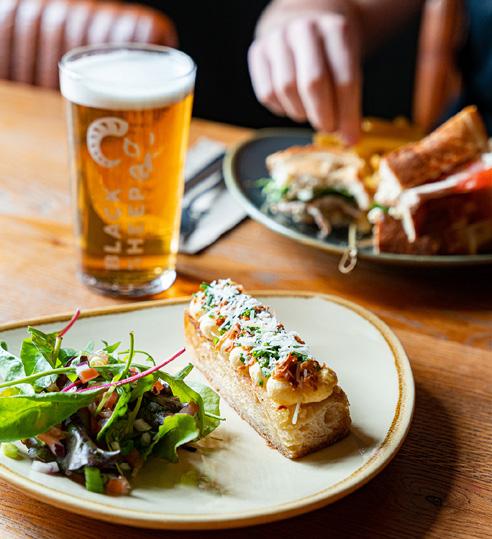
Join us for lunch or dinner at the Wensleydale Heifer, and you’re guaranteed a meal to remember. Using the very best locally sourced and freshest ingredients, our chefs create delicious dishes perfect for fine dining or a more casual meal.

Choose from our a-la-carte menu and you’ll find choices ranging from luxury classics such as gorgeous fresh oysters, sumptuous steak and decadent lobster through to our very famous Fish and Chips and much more!



Our famous Fixed Price Lunch Menu, available Mon-Sat, is packed full of delicious Heifer classics and creative dishes and just £25 for two courses and £32.50 for three courses.

Book online at www.wensleydaleheifer.co.uk
And don’t forget our stunning Sunday lunch, the best you’ll find in Yorkshire! Book early to avoid disappointment.
No matter the occasion, we make it even more special! So if you’re joining us for a celebration, let us know and you’ll find your table holds some extra special treats!
There’s extensive vegan and vegetarian options available too and all dietary needs are catered for. We have an exclusive children’s menu and some areas of the Heifer are dog-friendly too!

Emily Scott shares some luscious dishes to make for friends and family
Helford Blue, Spring Onion, Leek, Crème Fraîche & Thyme Tart
Soft, pale and delicious

Perfect rounds of delicious crab
Cornish Crab Cakes

Butterflied Leg of Lamb Roasted over Coals with Lemon, Garlic & Thyme
A wonderful way to cook lamb
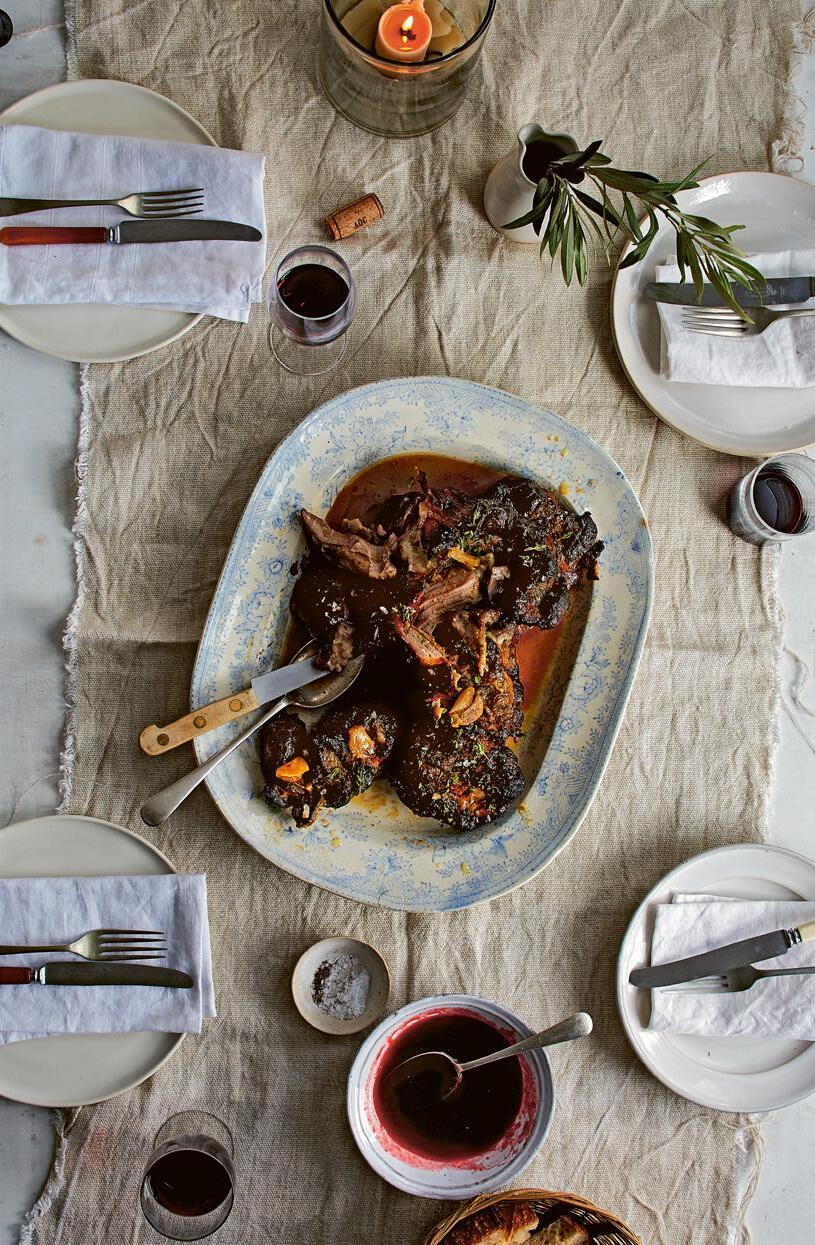
Raspberry Ripple Ice Cream

When it comes to ice cream my favourite will always be raspberry ripple

Shortcrust pastry, blue cheese, sweet leeks, free-range eggs, mascarpone and herbs. Soft, pale and delicious Helford Blue cheese is one of my favourites. I always have it on my cheese board and its creamy texture works beautifully with the alliums here.
For the shortcrust pastry
250g plain flour, plus extra for dusting
100g unsalted butter
a pinch of Cornish sea salt
2 medium free-range egg yolks
2–3 tablespoons milk
For the filling
50g unsalted butter
225g leeks, trimmed, washed and sliced (discard any tough outer layers)
4 spring onions, trimmed and sliced
2 tablespoons thyme leaves, plus extra to garnish
100g crème fraîche
100ml double cream
2 medium free-range eggs, plus 1 egg yolk
150g Helford Blue cheese (or similar)
Cornish sea salt and freshly ground black pepper
To make the pastry, combine the flour, butter, sea salt and egg yolks in a food processor and pulse. Once combined, let it down with a little milk until it all comes together as a dough. Cover with cling film and leave it to rest in the refrigerator for at least 2 hours.
On a lightly floured work surface, roll out the pastry to 1cm thick and use it to line a 22cm fluted loose-bottomed tart tin. Chill for 30 minutes. Meanwhile, preheat the oven to 200°C/180°C fan/gas 6. Blind bake the pastry case for 20–25 minutes, then trim off any excess pastry.
For the filling, melt the butter in a frying pan over a medium heat, add the leeks, spring onions and thyme, and gently cook for 8–10 minutes until softened. Whisk the crème fraîche, cream, eggs and egg yolk together in a bowl and season with salt and pepper. Arrange the leek and spring onion mixture over the base of the tart, crumble the Helford Blue on top, then pour over the cream mixture. Bake the tart for 25–30 minutes until golden and firm in the centre. Leave to rest for 10 minutes before slicing and serve with extra thyme leaves on top.
The pastry freezes well raw or even when blind baked. Swap out the leeks for slowly caramelised red onions and the blue cheese for goats’ cheese. Always cook alliums slowly, as this brings out their natural sweetness.
Perfect rounds of delicious crab, gently panfried until golden brown, these fish cakes are slightly lighter as they are potato-less. Accompany with a green salad and some citrus mayo.

500g mixed white crab meat, picked zest and juice of 1 lemon
4 spring onions, very thinly sliced
1 tablespoon chopped chives
2 tablespoons crème fraîche
4 tablespoons plain flour, plus extra for dusting
2 medium free-range eggs, lightly beaten
100g fresh white breadcrumbs
25g unsalted butter
4 tablespoons sunflower oil
Cornish sea salt and freshly ground black pepper
To serve citrus mayo
green leaf salad
lemon wedges
Put the crab meat in a mixing bowl along with the lemon zest and juice, spring onions, chives, and some salt and pepper. Mix together, adding the crème fraîche to help bind the mixture. Dust your hands with flour and divide the mixture into 8 round shapes, each about 2cm thick. Place on a plate and chill in the refrigerator for 1 hour. Put the flour on a plate and season well, pour the beaten eggs into a shallow dish, then scatter the breadcrumbs on a separate plate. Take a chilled crab cake and dip it into the flour, coating it on both sides, then dip it into the egg and finally the breadcrumbs. Set aside and repeat with the rest of the crab cakes. Heat the butter and oil in a large frying pan over a medium heat. To test if the oil is hot enough, place a breadcrumb or two into the oil; if it immediately turns golden brown, the oil is ready (do not leave unattended). Add the crab cakes to the pan (in batches) and fry for 3–4 minutes until crisp and golden brown underneath. Turn them over and cook for another 2–3 minutes until golden brown. Remove with a slotted spoon to a plate lined with paper towels and keep warm while you cook the rest. Serve with a green salad and dollops of citrus mayo, sprinkled with a little sea salt and with lemon wedges on the side.
Make your crab cakes bite-size for a drinks party (yes, an old-fashioned drinks party) and top with mayo and a small sprig of watercress.
This is a wonderful way to cook lamb in the oven or over coals. Splitting the joint effectively into a butterfly shape allows it to cook more quickly and evenly (the butcher can prepare the joint for you). This is such a zesty marinade for the lamb and I think it works best if left to marinate overnight. Serve with tzatziki in warmer weather or with damson and plum jam in the colder months.
2–2.5kg leg of lamb (weight before butterflying – ask your butcher to butterfly the lamb for you)
Cornish sea salt and freshly ground black pepper
damson and plum jam or tzatziki to serve
For the marinade
zest and juice of 3 lemons
1 tablespoon Dijon mustard
4 garlic cloves, crushed
3 tablespoons runny honey
2–3 tablespoons good olive oil
2 small bunches of thyme, leaves removed from stalks
Mix the marinade ingredients in a large bowl. Add the butterflied lamb to the bowl and rub the marinade all over the meat. Refrigerate for at least 3 hours, or even better overnight.
Bring the lamb back to room temperature before cooking. Remove from the marinade and season with sea salt and freshly ground black pepper.
Fire up the barbecue. When hot enough, cook the lamb over the hot coals for 45 minutes, turning it from time to time (or see Cook’s note for oven roasting).

Transfer the lamb to a board and allow it to rest for 15 minutes before slicing and serving.
In the spring and summer, serve with dollops of tzatziki, more lemon wedges and a green leaf salad. Alternatively, in autumn or winter, serve with my damson and plum jam and potato dauphinoise or some baby roast potatoes.
To cook the lamb in the oven, preheat it to 220°C/200°C fan/gas 8. Place the lamb in a roasting pan and roast for 15 minutes per 450g, then give it an extra 15 minutes. Baste the meat with the pan juices every 15 minutes.
My favourite ice cream will always be raspberry ripple. I make a vanilla base, gently roast the raspberries, layering them with vanilla ice cream.

Raspberry purée
500g raspberries
2 tablespoons caster sugar
2 tablespoons crème de cassis
Vanilla ice-cream base
350ml milk
400ml double cream
1 vanilla pod, split
6 free-range egg yolks
125g caster sugar
For the raspberry purée, preheat the oven to 190°C/170°C fan/ gas 5. Place the raspberries in a roasting tray and shake over the 2 tablespoons of sugar. Roast in the oven for 8–10 minutes until soft and juicy. Transfer to a food processor and blitz to a smooth purée, then pass through a fine mesh sieve to remove the pips. Add the crème de cassis, then set aside to cool. Cover and store in the refrigerator while you make the ice-cream base. For the vanilla ice-cream base, pour the milk and cream into a heavybased pan and add the split vanilla pod. Slowly bring to simmering point, then turn off the heat and leave to infuse for 10 minutes. Strain through a fine mesh sieve into a clean pan. In a separate large pan, whisk together the egg yolks and sugar, then pour in the warm cream mixture, stirring continuously. Place back on the stove and heat gently until it begins to thicken or you can run your finger through it on the back of a wooden spoon and your finger leaves a trail. Allow to cool, then cover and refrigerate overnight. The next day, churn the ice-cream base in an ice-cream maker until thick and creamy, according to the manufacturer’s instructions. I use a Magimix Gelato Expert ice-cream machine on the ice-cream setting. Spoon a third of the mixture into a container, then spoon over a layer of raspberry purée and gently swirl it into the base mixture. Repeat this process twice more, each time marbling the purée gently into the ice cream. Freeze for 3–5 hours or overnight. Serve scooped into cones or bowls.
The gelato setting on an ice-cream machine works beautifully too, giving you a light and airy ice cream. Swap out the raspberries for blackberries, blackcurrants or strawberries.
Recipes taken from Time & Tide by Emily Scott, published by Hardie Grant (£28). Photography by Kristin Perers.
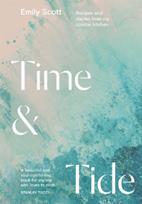
When the weather turns cold, what could be better than sitting by the fire and enjoying home-cooked food with family and friends?

I confess that I don’t really understand cheesecake as a dessert – not that I dislike it, it just doesn’t fill me with the joy that many seem to get. A savoury cheesecake, on the other hand, now that is something I can really get behind. As well as making a first-class lunch with salad, this also makes a different and exciting end to a meal – a cheese course in different form.
125g oatcakes
75g digestive biscuits
25g walnuts
100g unsalted butter, melted
300g cream cheese
300g ricotta cheese
150g freshly grated Parmesan
4 eggs
a small bunch of fresh chives, chopped
ground black pepper
20cm loose-bottomed or springform cake pan, greased
Whiz the oatcakes, digestive biscuits and walnuts to fine crumbs. Stir with the melted butter so that it resembles wet sand.
Press the crumbs into the base of the pan, and push them so they come a little way up the side of the pan. Chill for at least 30 minutes.
Preheat the oven to 150°C/gas 2.
Beat the cream cheese, ricotta and Parmesan together until smooth, then beat in the eggs and chives. Season with plenty of black pepper. Pour onto the base, then bake for 50 minutes–1 hour until set but with a slight wobble in the centre. Cool in the pan before turning out.
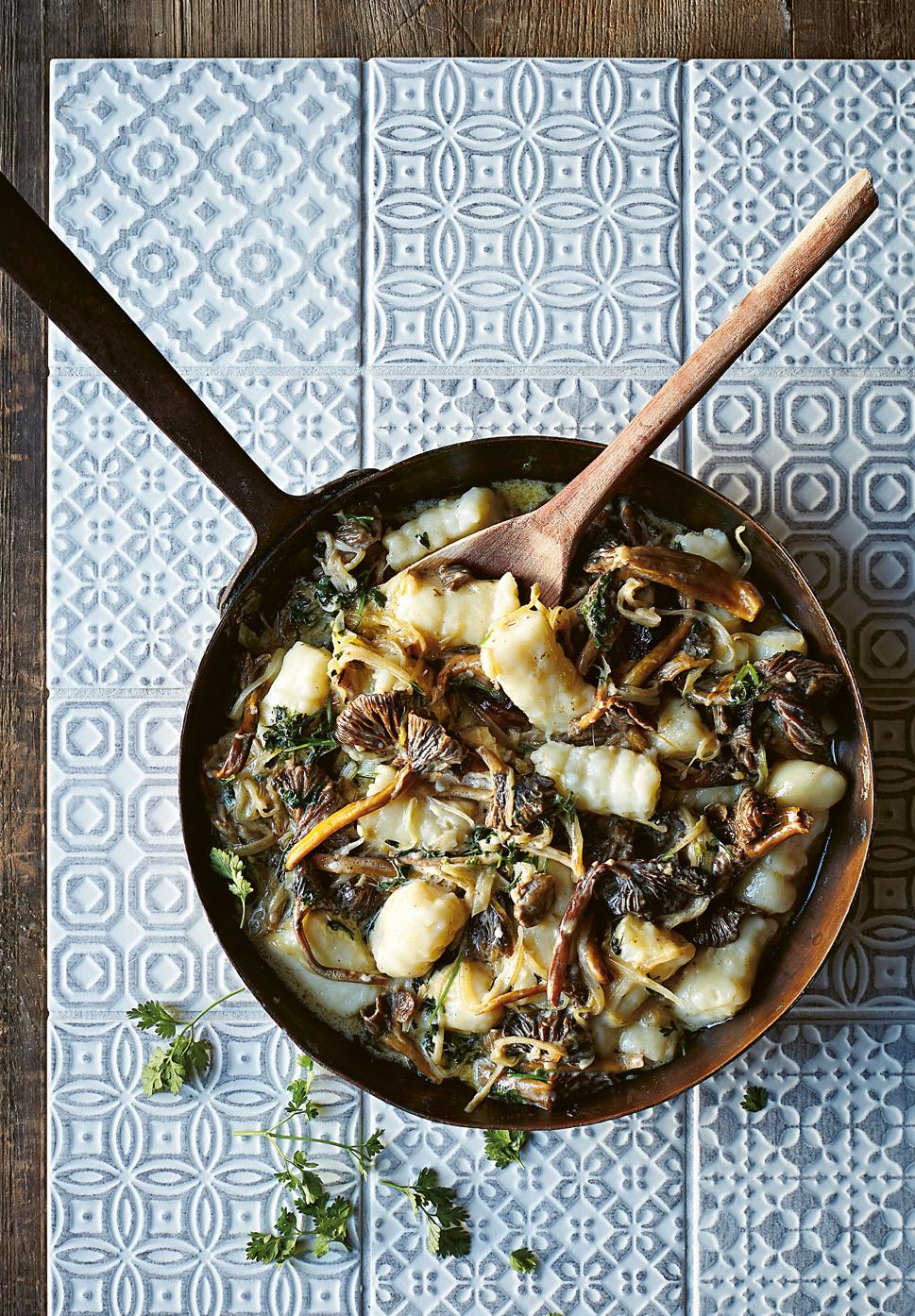
There is something undeniably comforting about little pillows of potato gnocchi. When cooked properly, they should be tender and fluffy rather than dense and heavy. If wild mushrooms aren’t in season, you can make this with white or portobello mushrooms.
SERVES 4–6
500g even-sized small floury potatoes, such as Maris Piper/ Yukon Gold, unpeeled
100g 00 flour, plus extra to dust
freshly grated nutmeg
1 egg, beaten
30g unsalted butter
1 tablespoon olive oil
2 banana shallots, finely chopped
2 garlic cloves, crushed
300g wild mushrooms, cleaned and sliced if large
75ml dry white wine
150ml double cream
a small handful of fresh parsley leaves, chopped fine sea salt and ground black pepper
freshly grated Parmesan, to serve
Cook the potatoes, whole in their skins, in boiling salted water for 25 minutes until they are tender.
Drain the potatoes and, once cool enough to handle, peel the skins off and mash the flesh using a potato ricer or by pushing it through a sieve/strainer so it is lump-free and fine.
Put the flour, 1 teaspoon salt and a little nutmeg into a bowl and add the potato, mixing with the blade of a knife. Make a well in the centre, add the beaten egg and mix together until well combined. Bring together with your hands but don’t knead or you could make your gnocchi tough.
On a lightly floured surface, roll out the dough into sausage shapes, about 1cm wide, then cut into 1cm pieces. Use the tines on the back of a fork to roll the gnocchi, giving them the characteristic ridges. Put on a floured baking sheet and chill until you are ready to cook. (You can cook them now or chill for up to 24 hours.)
Make the sauce. Melt the butter in a pan and add the oil and shallots. Cook for 10 minutes until softened and tender. Add the garlic and fry for a further 30 seconds then add the mushrooms. Increase the heat and fry for 10 minutes until they are golden brown.
Add the wine and bubble for a minute. Add the cream, a splash of boiling water to loosen it a little and plenty of salt and pepper, then stir in most of the parsley.
Bring a pan of salted water to the boil and add the gnocchi. They are cooked once they float to the surface, about 1–2 minutes. Scoop out with a slotted spoon and divide among warmed serving bowls. Warm through the sauce and spoon over the gnocchi. Scatter with the remaining parsley and serve.
An impressive dish for friends and family, the fillet/tenderloin of venison should be cooked so that it is still lovely and pink inside.
olive oil to fry and coat
50g unsalted butter
2 shallots, finely chopped
2 garlic cloves, crushed
150g button mushrooms, sliced
4 tablespoons brandy
100ml beef stock
75ml double cream
800g venison fillet/tenderloin
1 tablespoon freshly chopped fresh tarragon
sea salt and ground black pepper
Preheat the oven to 200°C/gas 6.
Heat a little oil and half the butter in a frying pan and gently fry the shallots for 10 minutes until softened.
Add the garlic and mushrooms and fry for 5 minutes until the mushrooms are golden brown. Add the brandy and bubble away until reduced by half. Pour in the beef stock and cream and simmer for 5 minutes.
Season the venison. Heat an ovenproof frying pan over a high heat with a little oil. Sear the fillet all over until browned. Add the remaining butter to the frying pan and spoon over the top of the fillet.
Transfer to the oven for 5–6 minutes. Set aside to rest, loosely covered in foil.
Add the tarragon to the sauce and warm through. Serve with the venison.


True strudel pastry is a work of art and well worth the effort of making your own. If you want to, you can use well-buttered layers of filo pastry instead, but it just doesn’t have quite the same texture, because it becomes quite brittle when baked.
350g plain flour
3 tablespoons neutral oil, such as vegetable oil, plus extra to grease
150–200ml lukewarm water
a pinch of fine sea salt
melted butter, to brush
2–3 tablespoons ground almonds
500g cooking apples, peeled and chopped
a handful of sultanas
150g caster sugar, plus extra to sprinkle
1 teaspoon ground cinnamon
a squeeze of lemon juice
Mix the flour, oil and water together with a good pinch of salt to form a soft dough. Knead the dough for 5 minutes until smooth and elastic, then pop into a lightly oiled bowl and leave to stand in a warm place, covered with a layer of clingfilm, for about 1 hour to rest. It might seem unusual to rest pastry in a warm place, but it will help you to be able to stretch it out later.
Roll the dough with a rolling pin on a board to a rectangle about 25 × 30cm. Cover your table with a clean, smooth cloth, then flip the strudel dough onto the centre of the cloth.
You now need to stretch the dough carefully with your hands. Think of it as a large pizza. Reach under the dough to the centre and, very gently, using the back of your hand (using your fingertips is more likely to cause tears), stretch the dough. Try to keep it in as much of a rectangle as possible. You want to finish up with a very large rectangle, about 75 × 50cm size. Make the dough as even as possible. (If you do make any little tears, pinch the dough together to patch them up.) Once you have a very thin, large rectangle trim, snip off the edges.
Preheat the oven to 220°C/gas 7. Brush the dough all over with melted butter and sprinkle with ground almonds. Mix the apples, sultanas, sugar and cinnamon together with a squeeze of lemon juice. Pile this filling along the bottom half of the dough, about 20cm from the bottom, leaving about 6cm on each side. Using the cloth to help you, flip the bottom of the dough over to cover the filling. Tuck the edges in to make them neat. Then, as you would roll a Swiss roll, use the cloth to roll up the strudel. Roll it onto a sheet of baking parchment and place on a baking sheet.
Recipes taken from Fireside

Food for Cold Winter Nights
by Lizzie Kamenetzky,published by Ryland Peters & Small (£18.99). Photography
by Nassima Rothacker © Ryland Peters & Small.Brush all over with more melted butter and sprinkle with a little sugar. Bake for 20 minutes, then reduce the oven to 190°C/gas 5 and bake for a further 20 minutes until golden. Cool a little, then serve, sliced, with cream.
These mouth-watering dishes are remarkably quick and easy to prepare
Cheddar and cider fondue
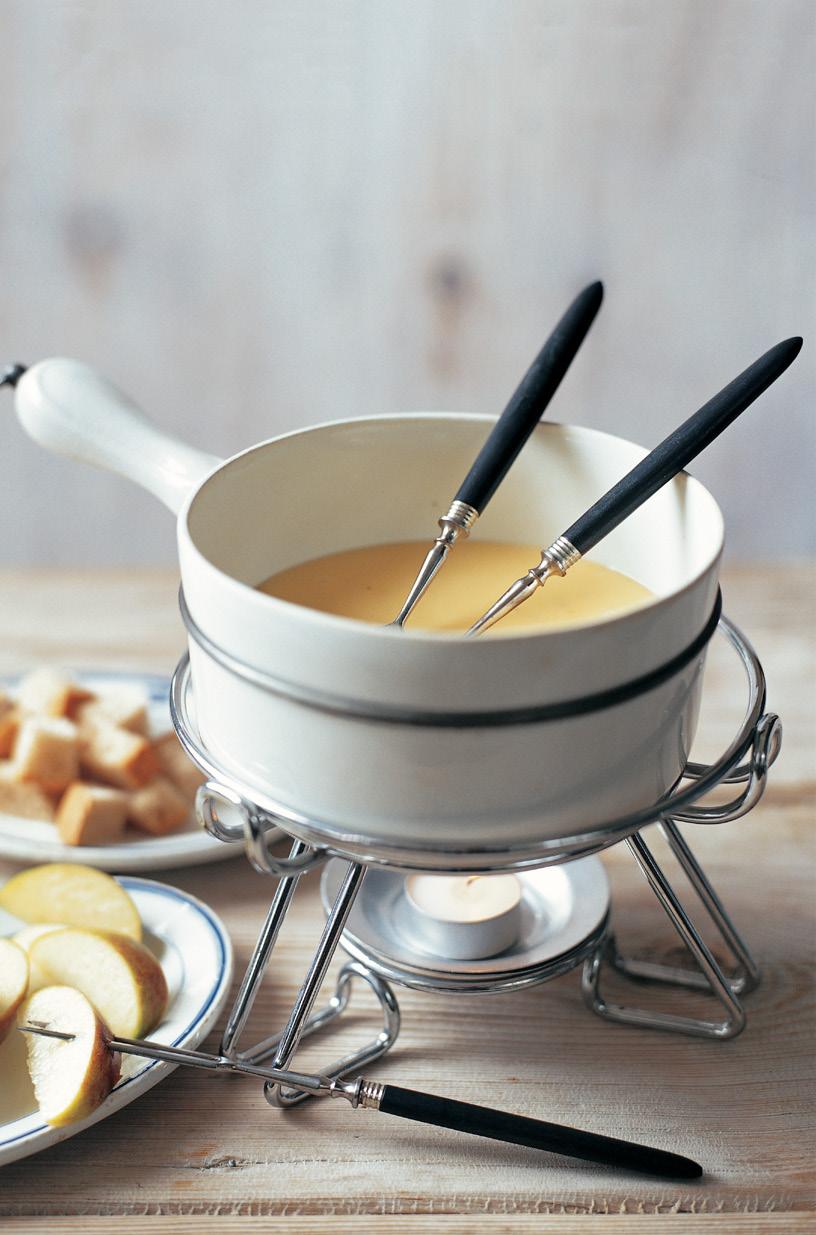
Blue cheese and steak winter salad


Chocolate and chestnut tart

Although the classic fondue recipe is Swiss, it’s perfectly possible to make it with other cheeses. This version is made from quintessentially British cheeses but Gruyère or Emmental work very well too. The key things to remember with fondue are to have your cheeses at room temperature before you start.
SERVES 2–3
about 430g thinly sliced or coarsely grated cheese, e.g.
150g mature Cheddar, 150g Double Gloucester and 130g Somerset Brie (all rinds removed)
2 teaspoons cornflour or potato flour
175ml dry but fruity cider
1 tablespoon medium-dry cider or Calvados
freshly ground white or black pepper
crusty wholemeal or granary rolls, cubed, to serve apple wedges, to serve
a cast-iron cheese fondue set
Toss the cheese with the cornflour. Set aside until it has come to room temperature.
Start off the fondue on your cooker. Pour the cider into your fondue pan and heat until almost boiling. Remove from the heat and tip in about one-third of the cheese. Keep breaking up the cheese with a wooden spoon using a figure-of-eight motion.
Once the cheese has begun to melt, return it to a very low heat, stirring continuously. Gradually add the remaining cheese until you have a smooth, thick mass (this takes about 10 minutes, less with practice). If it seems too thick, add some more hot cider. Add the brandy and season with pepper (preferably white, as the grains won’t show). Place over your fondue burner and serve with the cubes of bread. Use long fondue forks to dip the bread in, stirring the fondue often to prevent it solidifying. Have wedges of apple on hand to refresh you between mouthfuls of fondue.

Lay the steak on a sheet of parchment paper on a chopping board, cover with another sheet of parchment paper and beat with a meat mallet or rolling pin. Rub a little olive oil into both sides of the steak and season lightly with salt and pepper. Heat a ridged stovetop griddle until almost smoking, then lay the steak in the pan and cook for 1 minute. Turn and cook for 1 minute on the other side, then transfer from the pan to a plate.
250g lean steak, trimmed of any fat
extra virgin olive oil
1 onion, thinly sliced about 1 tablespoon balsamic vinegar
75g cherry tomatoes
55g rocket
60g Stichelton or Stilton, rind removed
sea salt and freshly ground black pepper
Turn down the heat under the pan slightly, smear a little oil over the onion slices and place them in a single layer in the pan. Cook for a couple of minutes until beginning to turn dark brown, then carefully turn and cook the other side. Set aside on another plate and drizzle over a little of the balsamic vinegar.
Finally, tip the cherry tomatoes into the pan with a little extra oil, if necessary, and roll them around until the skins begin to burst.
Cut the steak into fine slices with a sharp knife. Divide the rocket between 2 plates, top with the onions and arrange the tomatoes around the plate. Scatter over the steak slices and crumble over the cheese. Trickle over a little extra oil and balsamic vinegar and season with pepper. Serve immediately with crusty bread.


Use good-quality undyed smoked haddock fillet for best results. Serve the gratin with sautéed green beans or, if you are serving it as a midweek meal, then a green salad is all that’s required.
1.5kg potatoes
1 bay leaf
15g dried wild mushrooms
1 onion, chopped
2 tablespoons olive oil
150g white mushrooms, sliced
125ml dry white wine
280g undyed smoked haddock fillet, shredded, bones removed
a large handful of fresh flat-leaf parsley leaves, chopped
265ml single cream
250ml milk
2 tablespoons butter, melted sea salt and freshly ground black pepper
a 33 x 21cm oval baking dish, greased
Put the potatoes in a large saucepan, add the bay leaf and add sufficient cold water to cover well. Parboil until almost tender when pierced with a knife. Drain. When cool enough to handle, slice into 1⁄2 cm thick rounds. Put the dried mushrooms in a heatproof bowl and add sufficient boiling water to cover. Soak for about 15 minutes, until soft. Discard all but 2 tablespoons of the soaking liquid. Drain the mushrooms, chop coarsely and set aside.
Preheat the oven to 200°C/gas 6. Put 1 tablespoon of the oil in a large frying pan and add the onion. Cook for 3–5 minutes, until soft. Add the white mushrooms and the remaining oil and season well. Cook, stirring, for 3–5 minutes, until the mushrooms begin to brown. Add the wine and reserved mushroom soaking liquid and cook for 1 minute. Stir in the dried mushrooms, haddock and parsley and cook for 2–3 minutes. Combine the cream and milk in a small bowl or jug, season and set aside.
To assemble, arrange half the potato slices on the bottom of the prepared dish (save the most even and attractive slices for the top layer). Sprinkle lightly with salt. Spread the fish mixture in an even layer on top of the potatoes. Top with the remaining potatoes, arranged neatly. Sprinkle lightly with salt, then pour over the cream mixture. Brush the top with melted butter and bake in the preheated oven for about 1–11⁄2 hours, until golden. Serve immediately.
Preheat the oven to 180°C/gas 4.
To make the pastry, put the flour, cocoa, butter and sugar in a mixer and blitz until you get crumbs. Add the egg and mix again. Take the dough out of the mixer and bring together into a ball. Put the dough on a lightly floured surface and roll with a rolling pin until 3–4 mm thick. Line the tart pan with the pastry and chill in the refrigerator while you prepare the filling.
Chocolate shortcrust pastry

25g plain flour
25g cocoa powder
125g unsalted butter, chilled and cubed
85g golden caster sugar
1 egg
Chestnut filling
35g unsalted butter, at room temperature
35g golden caster sugar
1 egg
60g plain flour
1 teaspoon baking powder
30g cooked chestnuts, chopped
35ml double cream, chilled
2 tablespoons cold water
90g canned sweetened chestnut purée
Chocolate ganache
50g milk chocolate, finely chopped
50g dark chocolate, finely chopped
190ml double cream
a 23cm loose-based fluted tart pan, greased
To make the chestnut filling, cream the butter and sugar in a mixing bowl until light and fluffy. Add the egg and mix well. Mix the flour, baking powder and chestnuts together in a separate bowl, then mix into the wet ingredients. Finally, slowly add the cream and water and incorporate well.
Remove the tart shell from the refrigerator and spread the chestnut purée over the base. Spoon the chestnut sponge on top and spread evenly. Bake in the preheated oven for 20 minutes, or until the dough has risen and is pale gold. Remove from the oven and leave to cool for a few minutes. Trim the top of the filling if it has risen too much.
To make the chocolate ganache, put the chocolate in a mixing bowl. Put the cream in a saucepan and gently bring to the boil over low heat, stirring frequently. Pour into the mixing bowl and whisk until you get a smooth cream. Leave to cool for 10 minutes, then pour it into the tart. Refrigerate and serve chilled.
Recipes taken from Comfort: A Winter Cookbook published by Ryland Peters & Small (£20). Photography © Ryland Peters & Small.
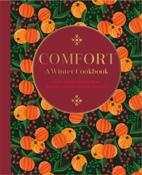
THE TRAVEL LOUNGE IS RENOWNED FOR ITS EXCELLENT SERVICE AND COMPETITIVE PRICES.
Our friendly expert team is second to none and uses their extensive knowledge to create the perfect holiday, just for you.
Our in-depth experience and proven high levels of service are supported by the financial security of being fully ABTA-bonded.

This South Asian island is brimming with rich history, diverse culture, spectacular wildlife, stunning landscapes and unparalleled experiences

ooking for something more than just a beach holiday?
“Sri Lanka has it all,” says Linda of Bedale-based travel experts The Travel Lounge.

“Yes there are fantastic golden beaches but you’ll also find stunning scenery, amazing wildlife and a wealth of cultural treasures –in fact the country is home to nine UNESCO World Heritage sites!”
The distinctively shaped island, formerly known as Ceylon, has been romantically dubbed “the teardrop of India” – which perhaps explains its popularity with honeymooners. Mind you, this very much ‘on trend’ destination is also a big hit with newly retired couples and anyone with an appetite for ‘soft adventure’.
Sri Lanka is world-famous for its biodiversity, and the country’s national parks are havens for leopards, elephants and a huge variety of colourful birds. The balmy waters of the Indian Ocean offer the chance of seeing whales, dolphins, sea turtles and much more besides.


The country’s ‘cultural triangle’ includes the sacred city of Anuradhapura and the ancient cities of Polonnaruwa and Sigiriya, this last being an astonishing ancient rock fortress decorated with colourful frescoes and an enormous carved stone lion. Sri Lanka’s tea plantations are another ‘must see’, not only for the chance to learn the story behind the world’s finest tea, but also for their breathtaking lush green scenery.
The best time to go? Pretty much whenever you like. Apart from in the cool central highlands, temperatures average a steady 30ºC all year round. The trick is to avoid the monsoon rains, so head for the southwest coast from November to March or the east coast from April to October.
The Travel Lounge is at 11 Market Place, Bedale. Call them on 01677 427358 or email sales@thetravellounge.co.uk







here’s no doubting the appeal of Toby Jugs. First created more than twoand-a-half centuries ago, these quirky novelty ceramics are still being made –and collected – today.
Some can be surprisingly valuable. “Toby Jugs were at their height of collectability between 1960 and the late 1980s, but good early examples from the late 1700s to the early 1800s are still much sought after nowadays,” says Jody Beighton, auctioneer and valuer at Tennants Auctioneers in Leyburn. “This spring, for example, a Yorkshire Prattware Toby Jug from around 1810 went under the hammer for £1,800.”
Toby Jugs were first produced in Staffordshire in the 1760s by Ralph Wood of Burslem, explains Jody. These early examples were tankards in the form of a plump seated gentleman wearing a three-cornered hat and brandishing a jug of ale. The dipped front of the hat served as a spout, and its detachable crown served as a lid or cup – although most of these have been broken or lost over the years.
Just why these pitchers were named ‘Toby’ Jugs is not entirely clear. One possibility is that they represent a hard-drinking beerlover, Yorkshireman Henry Elwes.
Elwes was reputed to have consumed 2,000 gallons of strong ale (‘stingo’) from his favourite tankard over the course of his lifetime. He was posthumously celebrated in Francis Fawkes’ 1761 poem The Brown Jug under the nickname ‘Toby Fillpot’, a ‘thirsty old soul’ who died ‘full as big as a Dorchester butt’.
Toby’s tricorn hat was already falling out of fashion by the time Ralph Wood modelled his first version of this minor celebrity. The Toby Jug itself, by contrast, quickly became a ceramic meme, rapidly changing and evolving as time went by.
Not only was the insatiable drinker depicted with an increasingly wide variety of props – a clay pipe, a dog, a miniature Toby Jug – but he also started popping up in a variety of different physical forms including spotty Tobies, redfaced Tobies and thin Tobies.





In fact enterprising potteries, including Ralph Wood’s, were soon producing Toby Jugs that dropped all pretence of depicting the original Toby Fillpot. Jugs were modelled as popular character-types such as sailors or squires, or as notable individuals of the day, such as Martha Gunn, a go-getting Brighton lady who established herself as the resort town’s leading ‘dipper’ or bathing machine operator.
Ralph Wood’s original Toby Jugs were made of earthenware and created using a soft clay mould. Their glazes tend to be translucent and rather muted by comparison with their gaudy Victorian counterparts.
The affordability of Toby Jugs was key to their popularity. And they were soon to become more affordable still, thanks to the technique of slip-casting using plaster of Paris moulds, originally introduced to the Staffordshire potteries by Frenchman Ralph Daniel.
“Slip-casting not only enabled easier and quicker production, it also meant a finer level of detail could be achieved. This in turn made it easier for pottery manufacturers to represent particular individuals,” says Jody. “Toby Jugs continued to be manufactured by the likes of Doulton, Royal Worcester and Wilkinson, who in later years produced the World War 1 Allied Commanders collection, a series which is highly collectable today.”
The idea of producing Toby Jugs in the form of wartime leaders – which had begun as early as 1785 when Ralph Wood made a Toby Jug representing Admiral Lord Howe – continued into the 1940s. For example Clarice Cliff, better known for her cheery tableware, created a Toby Jug depicting Winston Churchill as First Lord of the Admiralty, the position to which he was appointed the day Britain declared war on Hitler’s Germany.

The continuing popularity of Toby Jugs spawned a new, closely related form of novelty pottery in the form of the ‘character jugs’ that Royal Doulton produced from the mid-1930s onwards. Whereas Toby Jugs represent a complete figure, seated or standing, character jugs feature just the head, or head and shoulders, of the individual depicted. The rarer character jugs are also very collectable, but sadly lack the naive charm and folksy wit of their late 18thand early 19th-century ancestors.
For more information about Tennants Auctioneers, or to arrange a valuation, visit tennants.co.uk or call 01969 623780.
The Toby Jug quickly became a ceramic meme, rapidly changing and evolving as time went by.
• Ornate plaster restoration • Cornice restoration
• Traditional lime plastering
• Lime rendering techniques
Based
Plasterers
We have a national reputation for repairing, manufacturing and installing the very best heritage, traditional and contemporary plasterwork. Whether you’re looking for a ceiling rose for your home or the large-scale restoration of a historic property, we can help.




The brewery is open 7 days a week from 12pm in Masham, North Yorkshire, situated on the edge of the beautiful Yorkshire Dales.
To book a table or a tour, or for anything else, please call 01765 680 101, email visitor.centre@blacksheep.co.uk, or head to blacksheepbrewery.com
Dogs are welcome! Disabled access available for Bistro & Bar. We recommend you book in advance to avoid disappointment. Follow us on social media
Want to know more? Join one of our famous brewery tours! Our passionate tour guides know Black Sheep inside and out, and will talk you through the history and art of brewing whilst shepherding you through our unique brewhouse.

Naturally, the tour ends at the bar for a tasting of our range!
There’s no better place to drink our beer than direct from the source! Naturally we serve the full range of Black Sheep cask, keg and bottled beers, ciders and spirits – 7 days a week from 12pm!
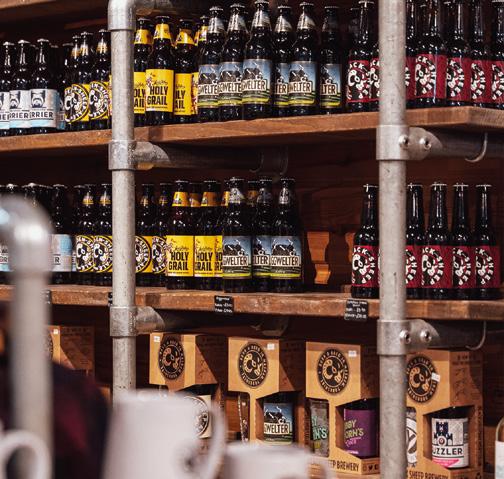
Grab a table and choose from our diverse menu of locally-sourced Yorkshire pub classics – a few of which feature our beer! Our menu features something for everyone!
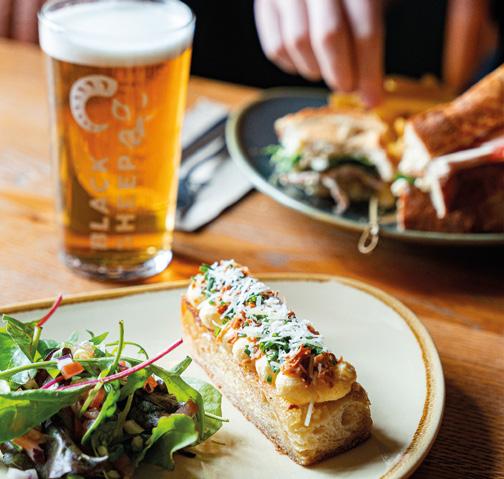
While you’re here, you might as well stock up! Our shop features:
ALL OUR BEERS
MERCH GIFTS & HAMPERS
LOCAL PRODUCE
Masham, Ripon, HG4 4JH 01765 680900 swintonestate.com
18–19 September
Looking to perfect your front crawl?
Taught by Salim Ahmed, founder of SwimLab, you will learn to perfect your front crawl technique, increase your speed and improve your endurance. Stay in the opulent Swinton Park Hotel during your retreat, which also includes forest walking, yoga, wild swimming, pool sessions, nutritious breakfast and lunches.
From £295 per person.
18, 22, 25 and 29 October
With this workshop, participants will be introduced to a number of birds of prey, many of which are indigenous to the British Isles. They will have the opportunity to get close to the birds and photograph them in a variety of spectacular settings and landscapes. £99 per person.
To book visit essence-of-light.com/ birds-of-prey-photo-workshops
18 November and 12 December
Learn how to create edible gifts to give to friends and family to really show you care.
Skills may include: pickling, jam making, chutneys, French macarons, biscuit making, Christmas truffles, fudge and potted meats.
Recipes may include: pickled seasonal vegetables, seasonal fruit jams, French macarons, biscuits, potted pork and chocolate fudge.
From £100 per person.
22, 27, 28 and 29 November
Susie Hart of Hart Company will demonstrate and help you create your own beautiful wreath with greenery and berries from our estate for you to take home – the perfect welcoming addition when decorating your home for Christmas. Indulge in a two-course lunch, plus festive music while you work!

Arrive at the Deer House at Swinton Park for the wreath making before making your way to Swinton Park for lunch in the Private Dining Room. £105 per person.
25 and 26 November
Practise the Wim Hof Method at this half day spa day at Swinton Country Club and Spa. A Wim Hof Method instructor will guide you through a breathing class before ‘cold exposure’, ultimately helping to unlock a host of benefits including increased energy and better sleep. £145 per person.



Church Bank, Aysgarth, DL8 3SR 01969 662829
yoremillcraftshopandgallery.co.uk
– An exhibition by Liz Salter
1 September–31 October




Liz’s paintings are lively and energetic evocations of the many moods of our wild hills and terrain. Her inspiration comes from walking and exploring wild and rugged landscape. Always looking, she often stops and draws, seeking to convey the feel of the place, the changeable weather and winds as well as the smell of the earth. She is attracted to the energy and wildness of the landscape and to the sense of its history and past being ever present. The paintings are made in her studio. She studies her sketchbooks looking for the drawings that speak of the experience. Then the adventure begins, exploring possibilities much as she explored new terrain. Images are built up on paper maybe using collage, liquid graphite, or ink. Layers of thin and thick acrylic paint are intermingled with line.
Liz draws on her memories as much as the sketches, remembering the scents on the wind and the changing light, vivid recollections of the experience. The painting becomes a visual equivalent for that experience with the colour reflecting her scrutiny and observation of the changes in the shape of the weather and the light on the land.

Trinity Church Square, Richmond, DL10 4QN 01748 826561 greenhowards.org.uk
Monday to Saturday 10am to 4.30pm
Special Exhibition: Great Escapes
Until Friday 22 December
Exploring a rich history of daring feats, escape and evasion, the kindness of strangers, personal sacrifice, split-second decision making, fighting retreats and real-life survival by the skin of your teeth. Included with museum entry.

Free Exhibition: We are Golden
Monday–Saturday, 10am–4.30pm
Free display celebrating the museum’s 50 years at home in the centre of Richmond. collection, usually concealed in our special stores. A
Wednesdays and Thursdays in September, 2pm
Take a walk round Richmond with your knowledgeable
Serving
We offer stress free access to a vast range of different products and mouth-watering surprises such as:
• A range of own-label and every day groceries

• Innovative products from start-ups and artisans
• Succulent local meat from ‘Dales’ farmers


• National and international delicacies on a rst-class delicatessen counter
• An extensive choice of artisan and mainstream cheeses from around the world
•A range of ready meals created by our butchers

• An unrivalled selection of worldwide wines and spirits
• Beer and spirits from craft breweries and distillers ……….and there is so much more in store.

Bedale, DL8 2PS 01677 425323 thorpperrow.com
13 September, 10am–3pm
Explore the Arboretum’s abundance of edible wild treats in our plant foraging workshop. Join our expert, Paul Holden Ridgway, as he leads you through Thorp Perrow on a hunt for forest- and field-based food and you will learn how to forage from nature’s seasonal pantry in a safe and sustainable way. £70 per person.
19 September, 10am–12noon
Spending time in nature is well-known as being beneficial for mind and body, so come along and experience our guided Mindfulness and Forest Bathing Walk, led by Faith Douglas, author of The Nature Remedy and Mindfulness Practitioner. £30 per person.
30 September, 15 October and 2 November, 10am–2pm
Join us on our ever-popular fungi workshops with the mycological maestro Dr Keith Thomas.
Dr Keith has a doctorate in microbiology and has worked with us on many other popular workshops. He is a fountain of knowledge and will show you around the Arboretum, introducing you to the world of fungi. You will also join in an identification and microscopy session. £50 per person.
5 October, 2pm–5pm
Embrace the arrival of this stunning season with a lively and informative tour followed by afternoon tea in the house!
Throughout the autumn months, the Arboretum’s collections of Acer, Cotinus and Liquidambar trees offer visitors a truly breathtaking spectacle of colour. Join our Curator, Faith Douglas, as she shares her passion for the season on a walk and talk around the Arboretum. Faith will show you the best of our National Collections and share some fascinating facts and care tips along the way. Afterwards you will be welcomed into Thorp Perrow Hall for a traditional afternoon tea with a glass of sparkling wine, all served in the dining room overlooking the beautiful grounds. £65 per person.

21 November, 10am–3pm
Create a beautiful festive wreath to welcome visitors to your home!
Led by our Curator, Faith Douglas, learn how to expertly craft a beautiful festive wreath using high quality foliage specially selected to provide a fantastic mix of varieties, colour, longevity and verdure. As well as greenery, there will be an assortment of delightful and interesting decorative items with which to adorn your wreath. £70 per person.
We are hot tub specialists and only supply the finest hot tubs on the market with unique features. With over 30 years’ experience, we pride ourselves on providing the correct hot tub for you and your family. Please visit our showroom or call us for further information.

A Bigger Splash, Unit 6, Brompton Industrial Park, Station Road, Brompton-on-Swale, N. Yorkshire DL10 7SN 01748 812039 www.a-biggersplash.co.uk abiggersplash2@aol.com
• CRANIOSACRAL THERAPY
• EMOTIONAL FREEDOM TECHNIQUE (EFT)
• COUNSELLING
• QUANTUM HEALING
• NUTRITION
• BIOENERGETIC SYNCHRONISATION
• TRANSFORMATION COACHING
• MINDFULNESS
• CHILD & TEEN THERAPY
• DRUMMING
To book please go to our website or call 07887 506163 to discuss a treatment suitable for you. Visit www.tanfieldwellness.co.uk for further details.
Tanfield Wellness is a team of therapists offering a holistic approach to healing, addressing mind, body and spirit. We specialise in trauma, stress, anxiety and depression, parent/child and family issues, chronic pain and a variety of other symptoms.

Zetland Estate, DL10 5HQ
01748 822888 kissthemoon.com
Autumn Events at Aske
9th Birthday Week
9–15 October
Celebrate nine years of helping people sleep beautifully with special offers in store and online at our Kiss the Moon HQ.
Christmas Kick Off
2 November, 4pm–7pm
Crack Christmas early with our Aske shopping event featuring delicious chocolate gifts from Mocha and the latest Kiss the Moon night-time aromatherapy goodies, our new home fragrance products, accessories and bedside essentials. Event special offers on the night.
Christmas Fayre
2 December, 10am–3pm
Come along to support some great local artists and artisans at our Kiss the Moon Christmas Fayre. Explore the night-time aromatherapy and sleep essentials, homewares, crafts, Christmas wreaths and decorations. Browse the stalls and enjoy hot drinks and food from our neighbours @mochaaske
Tennants, Harmby Road, Leyburn, DL8 5SG northernantiquesfair.eventbrite.co.uk
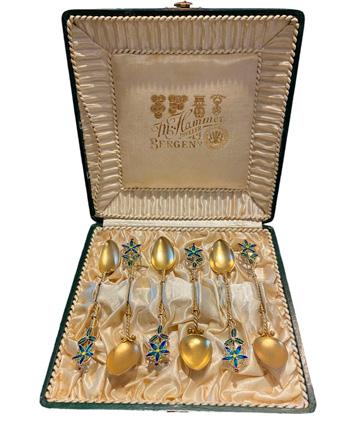
Thursday 28 September–Sunday 1 October
The unmissable Northern Antiques Fair, brimming with creative ideas, inspiration and fascinating works of art from all periods of history, is returning for the third year to The Garden Rooms at Tennants, Leyburn.

Presenting a wonderful mix of antique and contemporary works of art from the UK’s leading antiques and fine art dealers – selling period furniture, oil and watercolour paintings, glass, sculpture, clocks, silver, jewellery, ceramics, rugs and a wealth of decorative items, this event offers the ideal opportunity to catch up with family and friends as well as renewing or making new contacts with the dealers. Prices range from a few hundred pounds to five figure sums.
The Garden Rooms provide a very light, airy and modern setting complemented by the exhibitors maintaining a high standard of stand design. There is ample parking for everyone and enhancing the visit to the fair is the popular café, bar, bistro and gift shop.
£7.50 including programme and re-admission. Tickets available on the door and via Eventbrite.






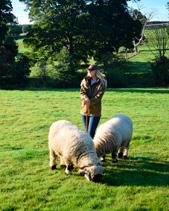
High Street, Leyburn, DL8 5AQ 01969 368006
Flower arrangement and wreath making courses at The Oak Room, Thornborough Hall, Leyburn, DL8 5AB
Elevate your flower-arranging skills and learn techniques to get the best out of your flowers. All equipment and refreshments included. To book contact info@rosemaryandtwine.co.uk
Autumn Vase Arrangement
Monday 9 October Morning 10am–12noon, Afternoon 2pm–4pm
Wreath Workshops
Thursday 12 October Afternoon 2pm–4pm, Evening 7pm–9pm
Christmas Wreath Workshops
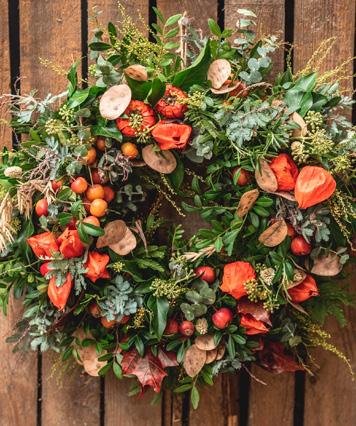
Monday 4 December
Morning 10am–12noon, Afternoon 2pm–4pm
Thursday 7 December Afternoon 2pm–4pm, Evening 7pm–9pm
Saturday 9 December
Morning 10am–12noon, Afternoon 2pm–4pm, Evening 7pm–9pm
7 Victoria Road, Richmond, DL10 4DW 01748 829789 thecheesepressrichmond.co.uk
Cheese Tasting
Thursday 5 October
Join us for an evening of cheese and wine on Thursday 5 October at 7pm.
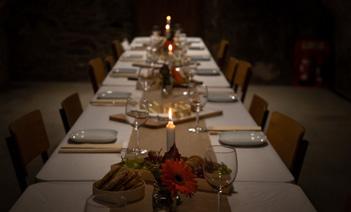
During the evening we’ll walk you through four cheeses served with accompaniments and paired with two wines (a glass of white and a glass of red) to complement each cheese.
Additional wine and non-alcoholic alternatives are also available to purchase on the night. Tickets are £30 per person.
Low Swinton, Masham, HG4 4JP swintongreen.com
Christmas Experience at Swinton Green
Saturday 4, 11 and 25 November
A magical experience at Swinton Green. Meet Little Alf and all the characters from the best-selling book series and enjoy a Christmas story with author Hannah Russell. Booking essential.
Christmas Shopping Morning at Swinton Green
Saturday 2 December
Come along and pick up your gifts for Christmas. Browse our popular books by Hannah Russell and our famous Quirky Cow artwork. Enjoy mulled wine, hot drinks and mince pies.


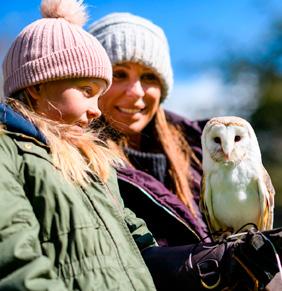







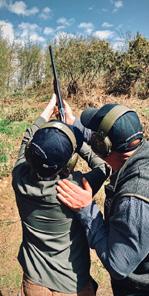

We o er a professional exterior cleaning service using low pressure, high temperature steam which is non-abrasive. Techniques approved by Historic England, which are used on stone, brick, cement and render to remove paints, bitumen, dirt, algae, mould and moss.


ALL AREAS COVERED
At Castle Timber Buildings we make an incredible range of buildings including sheds, stable blocks, garages, garden rooms and summerhouses.




All our designs are fully bespoke and made in the highest quality timber by our talented cra smen here in Yorkshire.
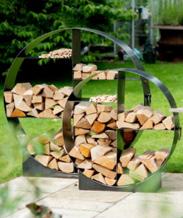






GUILDY HALL, MUKER
A traditional four bedroom country property with large gardens, small paddock and riverside frontage.
Guide Price: £850,000
Robin Jessop Ltd. 01969 622800 robinjessop.co.uk
LIME KILNS FARM, BRAIDLEY
A superb Grade II listed farmhouse with attached barn and large garden in need of renovation.
Guide Price: £575,000
Robin Jessop Ltd. 01969 622800 robinjessop.co.uk
SEATON COTTAGE, CARLTON
An immaculate three bedroom cottage in a popular village location with private rear garden.
Guide Price Range: £400,000 - £425,000
Robin Jessop Ltd. 01969 622800 robinjessop.co.uk
ELM HOUSE BARN, ASKRIGG
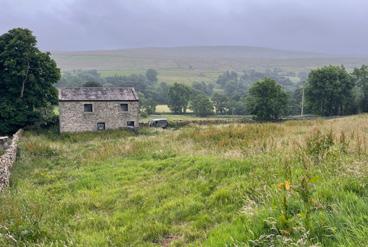
A beautifully presented two/three bedroom barn conversion with pretty gardens.
Guide Price: £375,000
Robin Jessop Ltd. 01969 622800 robinjessop.co.uk
BARN & LAND AT HORSEHOUSE, LEYBURN

A detached barn with full planning permission for a 2 bedroom dwelling and 3 acres of land.
Guide Price: £150,000
Robin Jessop Ltd. 01969 622800 robinjessop.co.uk
LAND AT CARPERBY, LEYBURN
4.97 Acres of productive grassland with stabling and roadside frontage.
Guide Price Range: £50,000 - £75,000
Robin Jessop Ltd. 01969 622800 robinjessop.co.uk


The Bay Horse, Ravensworth
Bear Cottage, Hawes
The Blue Lion Inn, East Witton
Booths, Ripon
Campbell’s of Leyburn
The Cheese Press, Richmond
The Co-op, Masham
Dovetail Interiors, Bedale
Fairhursts, Swinithwaite
The Greengrocer, Bedale
The Green Howards Museum, Richmond
Holme Design, Bedale
Kiplin Hall, Richmond
Kiss the Moon, Richmond
Lewis and Cooper, Northallerton
Mainsgill Farm Shop, Richmond
Mill Close Farm Shop, Hackforth
Milners of Leyburn
Mocha, Richmond
Northallerton Tourist
Information Centre
Pippin & Purdey, Bedale
Ripon Walled Garden
Rosemary & Twine, Leyburn
Sanderson & Co, Leyburn
The Station, Richmond
Stoneygate Farm Shop, Richmond
Tennants of Leyburn
Thorp Perrow Arboretum, Bedale


The Travel Lounge, Bedale
Wonky Tree Bookshop, Leyburn
Yorkshire Hideaways, Leyburn
See daleslife.com for details of more collection points to come.





Britannia Devereux are experts in domestic and commercial removals and storage; we can handle the complexities of packing, removal, storage and reinstallation of home contents, furniture and most other items or equipment. For more information please contact the office.


With over 75 years in the industry Devereux has grown from modest roots to become one of the UK's leading haulage firms. Based in Teesside, the UK’s largest industrial zone and freeport, Devereux are ideally located to provide transport and logistics to all of the UK, with easy access to the main road links in the area.





We pride our selves in creating a home from home, in a welcoming atmosphere. Our Residents enjoy savouring our fabulous restaurant quality meals and af ternoon teas as well as enjoying daily activities. All our homes have an excellent reputation in the local community. A Home for life.

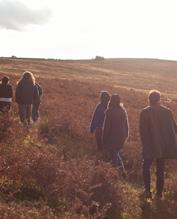
A beautiful range of accommodation across the 20,000 acre Swinton Estate, from the opulent Swinton Park Hotel; stunning family-friendly cottages; through to woodland Tree Lodges and the ‘Loft’ at Swinton Bivouac, with countless activities and experiences on the doorstep.




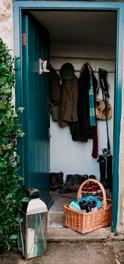









The Garden Rooms Bistro offers exceptional food in a unique setting. The passionate kitchen brigade pride themselves on delivering beautifully crafted dishes using the best Yorkshire produce; each highly seasonal menu offers an affordable choice of classic and modern British food delivered with outstanding service in a comfortable and relaxed environment
tennantsgardenrooms.com 01969 621146
Sedbusk
This beautiful country house hotel near Hawes serves delicious classic dishes using locally sourced ingredients. Visitors are welcomed daily for a sumptuous evening meal in its intimate restaurant or for a light lunch, afternoon tea, or coffee and cake in its comfortable Oak Room.

stonehousehotel.co.uk 01969 667571
With a new owner and new luxury rooms, The Blue Lion offers a warm welcome after a day out in the Dales. There’s an exciting new menu featuring food crafted from fresh local ingredients, and a wine list whose vintage section will delight Bordeaux lovers. Well behaved dogs are welcome.
thebluelion.co.uk 01969 624273
The White Bear’s talented chefs use locally sourced ingredients to create delicious seasonal dishes, and there’s an extensive wine list to complement the menu. You can enjoy your meal in the charming dining room or the traditional bar, with open fires creating a cosy atmosphere throughout.
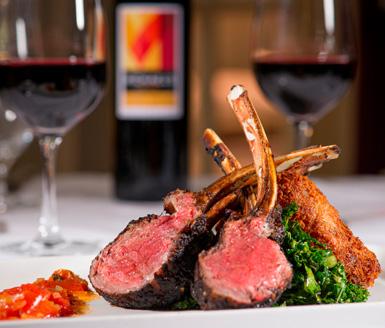
whitebearmasham.co.uk 01765 689319

Masham
From the award-winning, fine-dining experience in the grandeur of Samuel’s Restaurant to the more relaxed AA Rosette Terrace Restaurant and Bar, serving morning coffee, lunch, dinner and fabulous cocktails. Both restaurants showcase local and seasonal produce with much from the estate and four-acre walled garden. swintonestate.com 01765 680900
Masham
Tour the brewery, dine in the Bistro, and taste

The Black Sheep’s award-winning beers at the ‘Baa...r’. You can also buy lots of goodies from the well-stocked Sheepy Shop.
A ‘ewe-nique’ venue for corporate entertaining, product launches, parties and weddings!
blacksheepbrewery.com 01765 680101
Sample award-winning chef
Jonathan Harrison’s unique take on modern British cooking in The Sandpiper’s 40-seater restaurant or the cosy traditional bar serving local ales, fine wines and an extensive range of whiskies.

There are two tasteful boutique-style en-suite doubles for overnight guests.
sandpiperinn.co.uk 01969 622206
Grand honest food cooked to perfection, all locally sourced and freshly prepared. Situated on the Tupgill Park Estate near Middleham in the heart of the Dales.


The Saddle Room also has nine bed and breakfast units, seven cottages and a wedding venue that will seat 120 people.
thesaddleroom.co.uk 01969 640596




